Suitable for beginners to DIY. Advanced speaker bookshelf box made with professional tools
In order to make this box, I bought this tool... (continued) 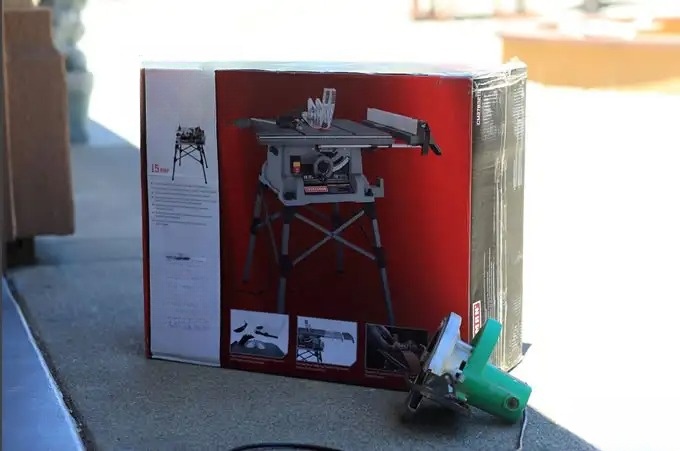
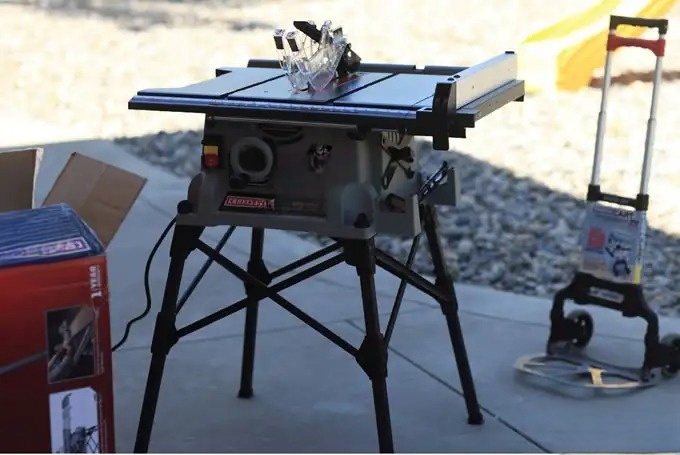
Newbie, open a box of materials first. One word: awesome!: It can cut iron like mud, and the size of each plate is accurate compared to a garden saw. Even Lu Ban is not as good as it. Newbies still need to use good tools to make up for the lack of technology . 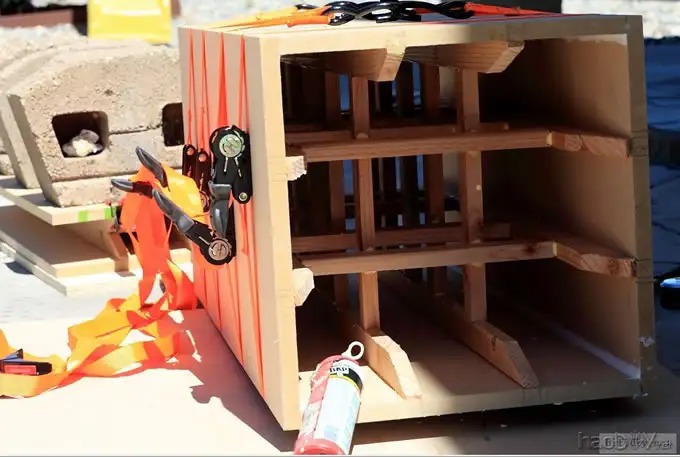
Add another layer of plywood. 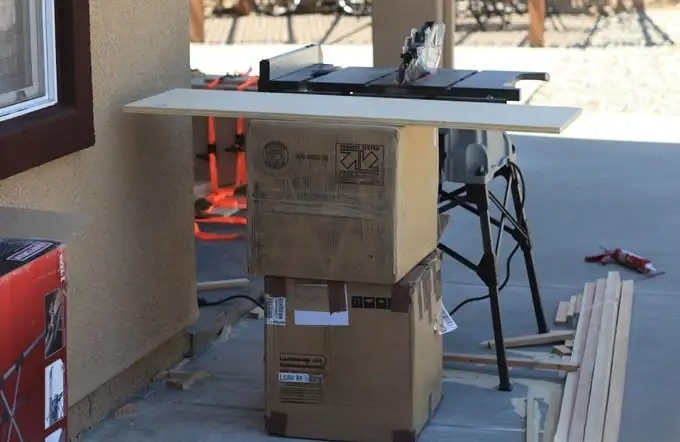
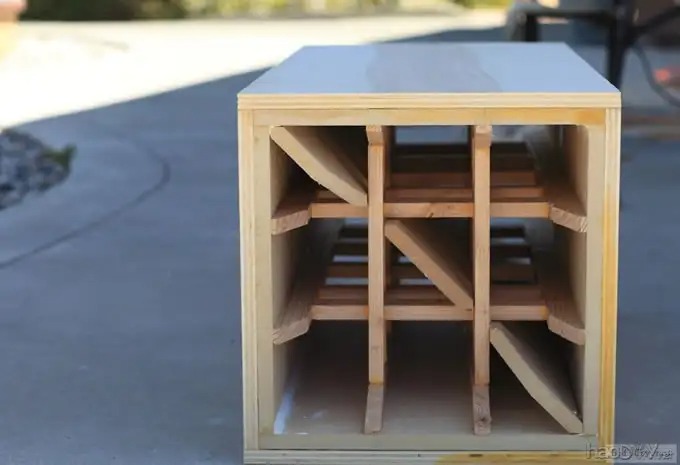
It is a reinforcement and fixation. As for the production of speakers, the real content is still to come. Now I will only introduce the structure of the box. What is emphasized here is mechanics, vibration prevention and reduction of standing waves. Thank you for your attention! 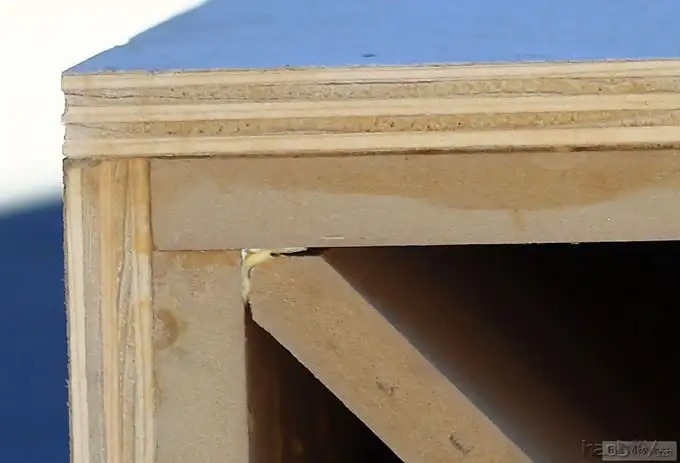
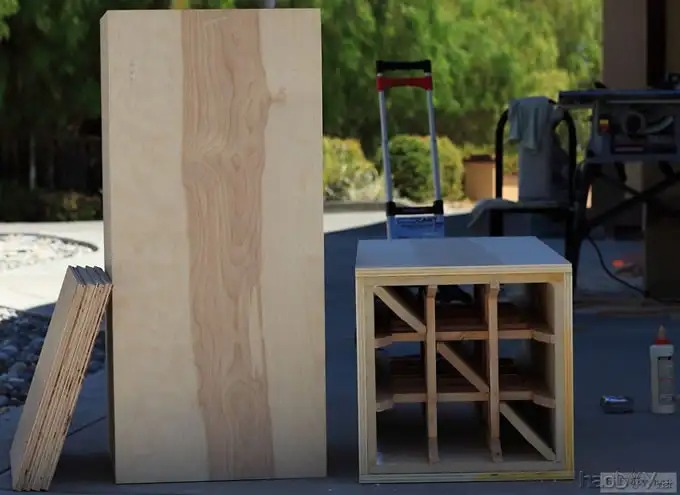
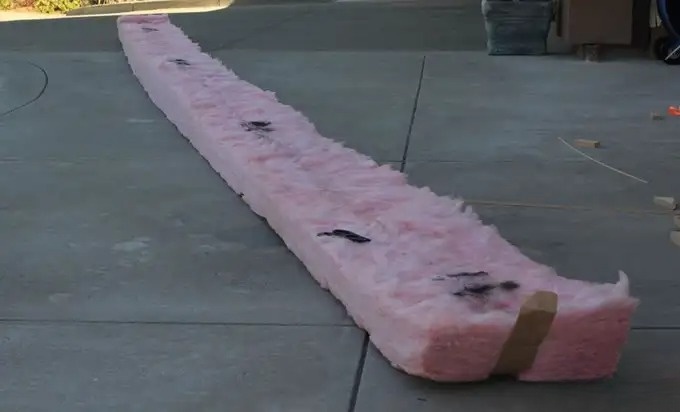 The table saw is really awesome. It is easy to cut out many decorative strips and box feet from a large wooden board, which saves a lot of money. I originally planned to buy a lot of decorative panels, but I didn’t expect the table saw to be so convenient. Awesome! Notice that the box is open from top to bottom, 15 inches. After adding the decorative panel, it looks more like a cabinet. The size is: 480X480X1200 (my sister, this is an auxiliary tool for cutting at 45 degrees. This is a small accessory that bears the weight of the large speaker. Maybe I am a frog in the well and have not seen other boxes in this kind of thing. #p#Page title#e# This is my first time to oil seven. I used to play with the spray seven in the bottle. Before; now; due to the effect of the light, the color on it is reddish, and the picture below is the real color . It is digital frequency division, but a speaker manager will be used, which makes it easier to make a box. Friends who are interested, please take a look at this post; http://bbs./viewthread.php?tid=613274 If you think the article is too long, you can go to the first 1 to 4 posts of this post. If you are interested or want to correct or communicate, please reply more, otherwise, some technical things are quite boring, and it is useless to write them, and they cannot be effectively shared. I will describe the main working principle of the bass reflex box or the empty paper plate passive radiator box in a nonsensical way : 1. Slow motion: Like the "pop tube" toys we played as children, use a bamboo tube or the rubber tube of a ballpoint pen as the cavity, forcefully stuff a ball of soaked paper into one end, and use an iron rod or chopsticks to wrap wet cotton around the other end as a piston, and push it hard into the cavity. After the air is compressed to a certain degree, the paper ball will actually shoot out towards your enemy or current lover with a pop sound. When the paper ball is in the cavity, it is like the air in the inverted hole, or like an empty paper plate that can move. The tighter the paper ball is pressed, the longer and thinner the inverted tube is, so the resistance to air movement in the tube increases, which is also equivalent to adding a heavy object to the empty paper plate. At this time, the piston The harder you push inward, the tighter the paper ball is stuffed, the greater the air compression. Once the paper ball is ejected, the faster it is and the more lethal it is. At this time, the speaker also compresses the air in the speaker box like a piston. The greater the resistance to the movement of the air in the bass reflex tube, the greater the air compression in the box. Once the air in the bass reflex tube is ejected, the faster it is, the greater the energy, and the lower the frequency of the sound produced. Similarly, the heavier the empty paper plate, the lower the frequency of the sound produced once it is pushed. This means: the longer the bass reflex tube, the smaller the diameter, the heavier the paper cone, and the lower the resonant frequency. #p#Page title#e# 2. Another toy: string together the elastic bands used to tie girls' braids, tie a large nut on one end, and swing the other end with your hand. After a certain period of time, the nut will swing to the far left, while your hand holding the elastic band will be at the far right. Just like the air from the inverted tube is sprayed outward, the empty paper plate moves outward, and the speaker also moves outward at this time, and the sounds they produce are in phase. The harder you swing, the greater the swing of the nut. At this time, the reaction force of the nut also increases, and the swing of your hand decreases due to the increase in the swing of the nut, so that We just shake our wrists. This game is very dangerous, do not play if you are over 18 years old! This means that at a certain frequency, the output of the bass reflex port or paper tray increases, while the output of the speaker decreases. We can design this frequency at the speaker's resonant frequency to suppress the noise generated by the speaker's inability to listen to the electrical signal control at this point. I don't know if the above superficial explanation is helpful to everyone. Anyway, I am used to using such low-level things to understand many advanced physics. To help design bass: 15 inches 1.Fs=18.8Hz Qts=0.36 Vas=232.2L Vd=1503.9cm x cm SPL=90.0db@1w/1m RMS800w 2. Passive radiator Fs: 22 Hz · · Qms: 3.90 · Cms: 0.16 mm/N · Mms: 345 g Sd: 818 sq. cm. · Xmax: 20 mm Midrange: 10 inches Fs: 66 Hz · SPL: 98.8 dB 1W/1m · Vas: 1.1 cu. ft. · Qts: 0.33. 350wRMS Treble: (You should be familiar with it. It sells for more than 300 US dollars in foreign countries. We support domestic products) One of the characteristics of aluminum ribbon tweeters is that when placed vertically, the deviation angle from the axis is allowed to be larger, which is much better than the dome tweeter, that is, the divergence angle is large. From the frequency response diagram provided by the product above, we can see that. I mentioned in this post http://bbs./viewthread.php?tid=613274: As for the tweeter, this is an expensive aluminum ribbon tweeter, which is much more expensive than JBL's famous chromium tweeter. You can see from the evaluation of high-quality aluminum ribbon tweeters on the Internet. From the spectrum measurement, we can see that its directional angle is much larger... When placed horizontally: On the contrary, the divergence angle is very small, much smaller than that of the dome, which means that the directivity is very strong. Looking at the picture of my speaker placement, we can see that the two boxes and the listening position are an equilateral triangle, and the two boxes are 60 degrees inward, and the tweeter is directly pointed at the audience. This speaker is only used by one person, and this listening environment is diffuse reflection for the tweeter. The microphone measurement shows that when it deviates from the axis, the drop is only accelerated above a dozen KHz. So it has little effect on the listening experience at other positions. This tweeter is placed higher than the human ear, and this direction just allows for a large angle. Users almost never sit to listen to music. My friend is really an expert. Impedance diagram of the bass box with an empty paper cone: (crossover frequency 100Hz) Impedance diagram of the bass speaker in the free state; (The figure shows that it is consistent with the parameter Fs provided by the manufacturer) Impedance diagram of the closed mid-range speaker; (Volume in the box Vb=Vas, Fb=Fs. Consistent with the parameter Fs provided by the manufacturer. Crossover frequency 100, 2K) I have been enjoying wonderful music with my method. In order to share my experience, I used justMLS to verify the box for the first time today. Such a novice is definitely suitable for communication between novices, and at the same time, experts will also see the problem. The above free impedance diagram is just the speaker on the box loosened the screws and placed obliquely at the box mouth, with the influence of the mid-range speaker on the top and the bass box on the bottom, and the measurement kit provided by the forum is not used. In a short time, the impedance difference between the speaker in the box and without the box is measured. Impedance diagram of the closed mid-range speaker; (Volume in the box Vb=Vas, Fb=Fs. Consistent with the parameter Fs provided by the manufacturer. Crossover frequency 100, 2K) I use the speaker manager to divide the sound, no problem, and I will explain it later. In addition, the information provided by the tweeter above states that it is recommended that the crossover point be above 1500Hz, and that a 4-valence crossover resonance be used, just like playing on a springboard, the higher you jump, in theory, you can jump to the moon! Similarly, the speaker will also resonate, at this time, it will generate a very high back electromotive force, canceling the signal voltage output by the amplifier. This is equivalent to extremely high impedance, and it is almost impossible to generate enough current to control the speaker, that is, once the speaker enters the resonant state, it no longer sounds according to the music signal output by the amplifier. This is one of the reasons why the bass is inaccurate . Therefore, it is very important to measure the speaker impedance to obtain its resonant frequency.
The table saw is really awesome. It is easy to cut out many decorative strips and box feet from a large wooden board, which saves a lot of money. I originally planned to buy a lot of decorative panels, but I didn’t expect the table saw to be so convenient. Awesome! Notice that the box is open from top to bottom, 15 inches. After adding the decorative panel, it looks more like a cabinet. The size is: 480X480X1200 (my sister, this is an auxiliary tool for cutting at 45 degrees. This is a small accessory that bears the weight of the large speaker. Maybe I am a frog in the well and have not seen other boxes in this kind of thing. #p#Page title#e# This is my first time to oil seven. I used to play with the spray seven in the bottle. Before; now; due to the effect of the light, the color on it is reddish, and the picture below is the real color . It is digital frequency division, but a speaker manager will be used, which makes it easier to make a box. Friends who are interested, please take a look at this post; http://bbs./viewthread.php?tid=613274 If you think the article is too long, you can go to the first 1 to 4 posts of this post. If you are interested or want to correct or communicate, please reply more, otherwise, some technical things are quite boring, and it is useless to write them, and they cannot be effectively shared. I will describe the main working principle of the bass reflex box or the empty paper plate passive radiator box in a nonsensical way : 1. Slow motion: Like the "pop tube" toys we played as children, use a bamboo tube or the rubber tube of a ballpoint pen as the cavity, forcefully stuff a ball of soaked paper into one end, and use an iron rod or chopsticks to wrap wet cotton around the other end as a piston, and push it hard into the cavity. After the air is compressed to a certain degree, the paper ball will actually shoot out towards your enemy or current lover with a pop sound. When the paper ball is in the cavity, it is like the air in the inverted hole, or like an empty paper plate that can move. The tighter the paper ball is pressed, the longer and thinner the inverted tube is, so the resistance to air movement in the tube increases, which is also equivalent to adding a heavy object to the empty paper plate. At this time, the piston The harder you push inward, the tighter the paper ball is stuffed, the greater the air compression. Once the paper ball is ejected, the faster it is and the more lethal it is. At this time, the speaker also compresses the air in the speaker box like a piston. The greater the resistance to the movement of the air in the bass reflex tube, the greater the air compression in the box. Once the air in the bass reflex tube is ejected, the faster it is, the greater the energy, and the lower the frequency of the sound produced. Similarly, the heavier the empty paper plate, the lower the frequency of the sound produced once it is pushed. This means: the longer the bass reflex tube, the smaller the diameter, the heavier the paper cone, and the lower the resonant frequency. #p#Page title#e# 2. Another toy: string together the elastic bands used to tie girls' braids, tie a large nut on one end, and swing the other end with your hand. After a certain period of time, the nut will swing to the far left, while your hand holding the elastic band will be at the far right. Just like the air from the inverted tube is sprayed outward, the empty paper plate moves outward, and the speaker also moves outward at this time, and the sounds they produce are in phase. The harder you swing, the greater the swing of the nut. At this time, the reaction force of the nut also increases, and the swing of your hand decreases due to the increase in the swing of the nut, so that We just shake our wrists. This game is very dangerous, do not play if you are over 18 years old! This means that at a certain frequency, the output of the bass reflex port or paper tray increases, while the output of the speaker decreases. We can design this frequency at the speaker's resonant frequency to suppress the noise generated by the speaker's inability to listen to the electrical signal control at this point. I don't know if the above superficial explanation is helpful to everyone. Anyway, I am used to using such low-level things to understand many advanced physics. To help design bass: 15 inches 1.Fs=18.8Hz Qts=0.36 Vas=232.2L Vd=1503.9cm x cm SPL=90.0db@1w/1m RMS800w 2. Passive radiator Fs: 22 Hz · · Qms: 3.90 · Cms: 0.16 mm/N · Mms: 345 g Sd: 818 sq. cm. · Xmax: 20 mm Midrange: 10 inches Fs: 66 Hz · SPL: 98.8 dB 1W/1m · Vas: 1.1 cu. ft. · Qts: 0.33. 350wRMS Treble: (You should be familiar with it. It sells for more than 300 US dollars in foreign countries. We support domestic products) One of the characteristics of aluminum ribbon tweeters is that when placed vertically, the deviation angle from the axis is allowed to be larger, which is much better than the dome tweeter, that is, the divergence angle is large. From the frequency response diagram provided by the product above, we can see that. I mentioned in this post http://bbs./viewthread.php?tid=613274: As for the tweeter, this is an expensive aluminum ribbon tweeter, which is much more expensive than JBL's famous chromium tweeter. You can see from the evaluation of high-quality aluminum ribbon tweeters on the Internet. From the spectrum measurement, we can see that its directional angle is much larger... When placed horizontally: On the contrary, the divergence angle is very small, much smaller than that of the dome, which means that the directivity is very strong. Looking at the picture of my speaker placement, we can see that the two boxes and the listening position are an equilateral triangle, and the two boxes are 60 degrees inward, and the tweeter is directly pointed at the audience. This speaker is only used by one person, and this listening environment is diffuse reflection for the tweeter. The microphone measurement shows that when it deviates from the axis, the drop is only accelerated above a dozen KHz. So it has little effect on the listening experience at other positions. This tweeter is placed higher than the human ear, and this direction just allows for a large angle. Users almost never sit to listen to music. My friend is really an expert. Impedance diagram of the bass box with an empty paper cone: (crossover frequency 100Hz) Impedance diagram of the bass speaker in the free state; (The figure shows that it is consistent with the parameter Fs provided by the manufacturer) Impedance diagram of the closed mid-range speaker; (Volume in the box Vb=Vas, Fb=Fs. Consistent with the parameter Fs provided by the manufacturer. Crossover frequency 100, 2K) I have been enjoying wonderful music with my method. In order to share my experience, I used justMLS to verify the box for the first time today. Such a novice is definitely suitable for communication between novices, and at the same time, experts will also see the problem. The above free impedance diagram is just the speaker on the box loosened the screws and placed obliquely at the box mouth, with the influence of the mid-range speaker on the top and the bass box on the bottom, and the measurement kit provided by the forum is not used. In a short time, the impedance difference between the speaker in the box and without the box is measured. Impedance diagram of the closed mid-range speaker; (Volume in the box Vb=Vas, Fb=Fs. Consistent with the parameter Fs provided by the manufacturer. Crossover frequency 100, 2K) I use the speaker manager to divide the sound, no problem, and I will explain it later. In addition, the information provided by the tweeter above states that it is recommended that the crossover point be above 1500Hz, and that a 4-valence crossover resonance be used, just like playing on a springboard, the higher you jump, in theory, you can jump to the moon! Similarly, the speaker will also resonate, at this time, it will generate a very high back electromotive force, canceling the signal voltage output by the amplifier. This is equivalent to extremely high impedance, and it is almost impossible to generate enough current to control the speaker, that is, once the speaker enters the resonant state, it no longer sounds according to the music signal output by the amplifier. This is one of the reasons why the bass is inaccurate . Therefore, it is very important to measure the speaker impedance to obtain its resonant frequency.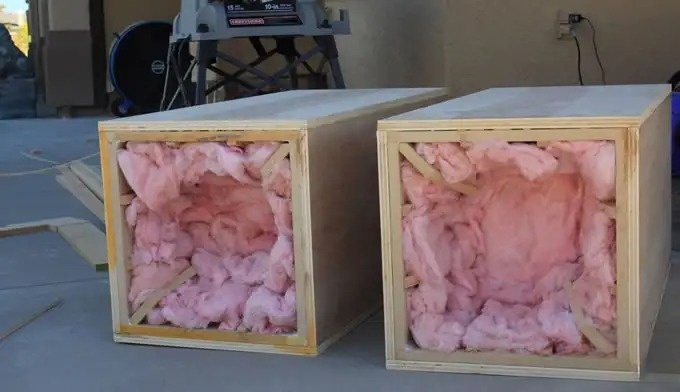
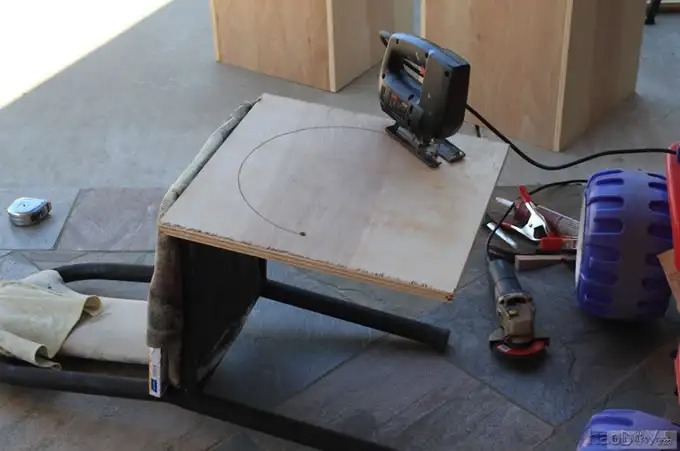
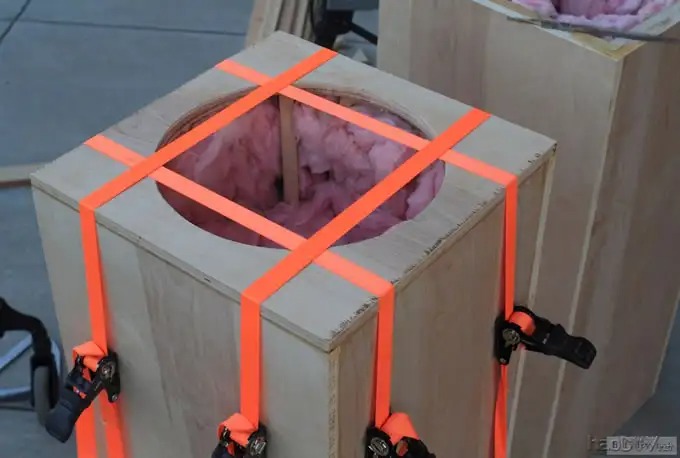
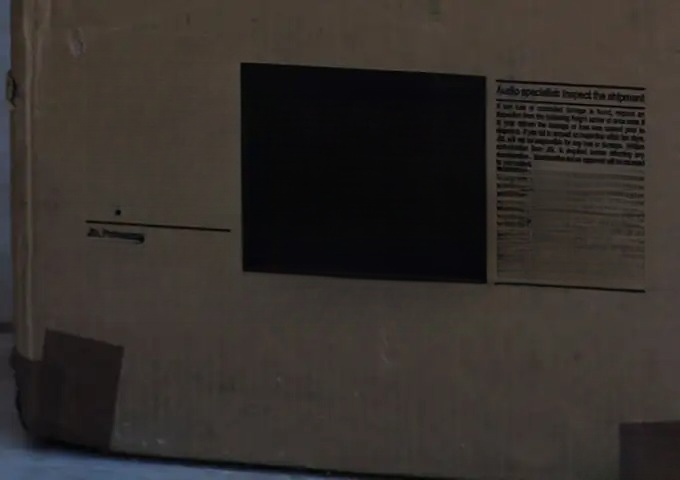
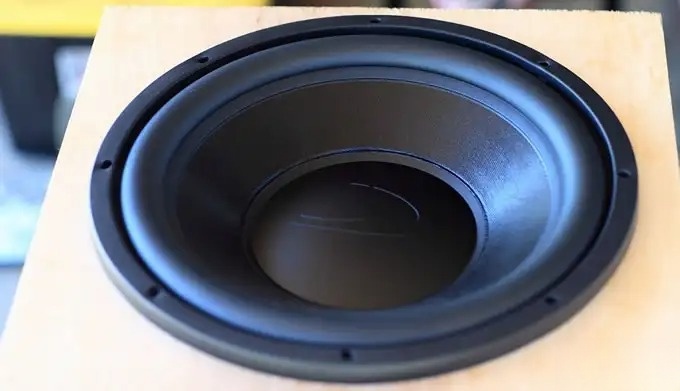
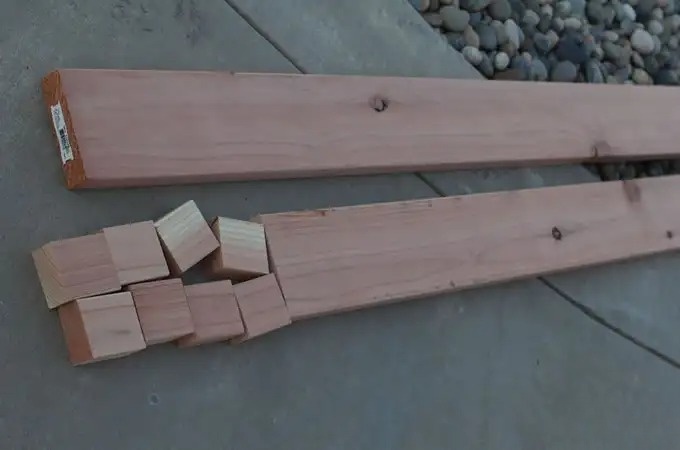
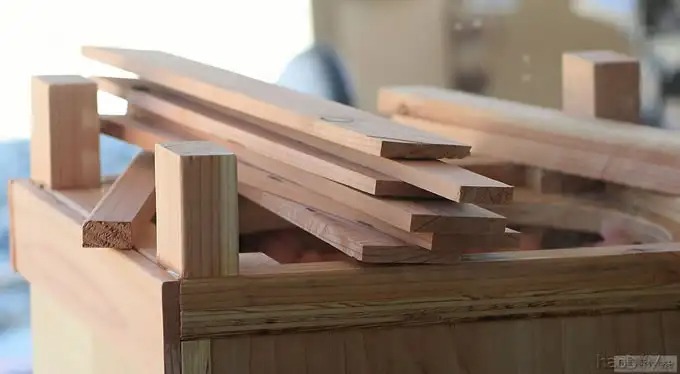
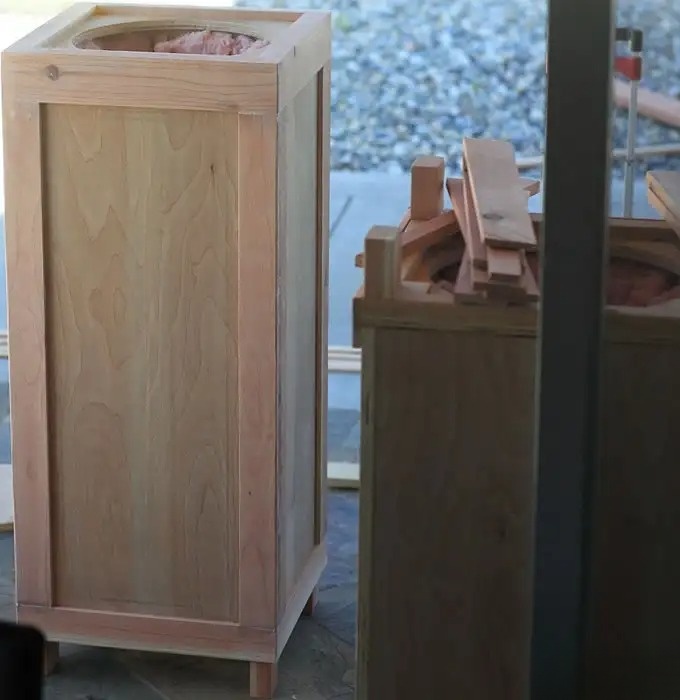
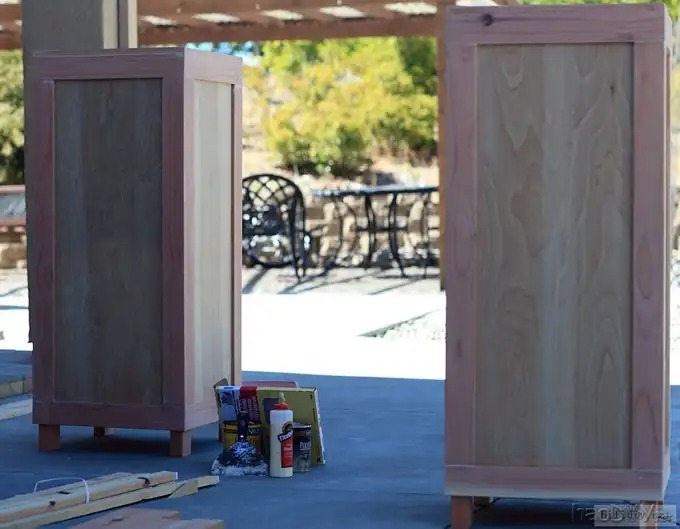
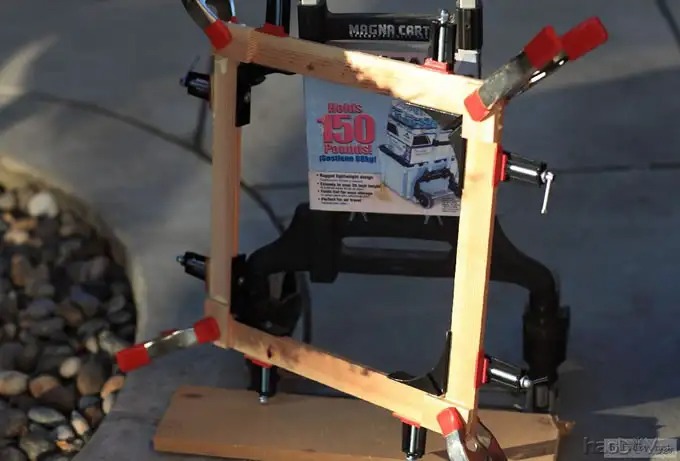
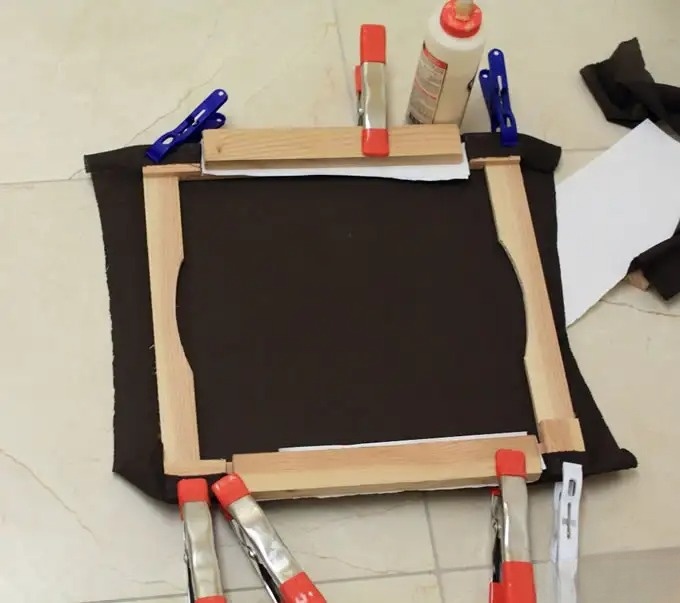
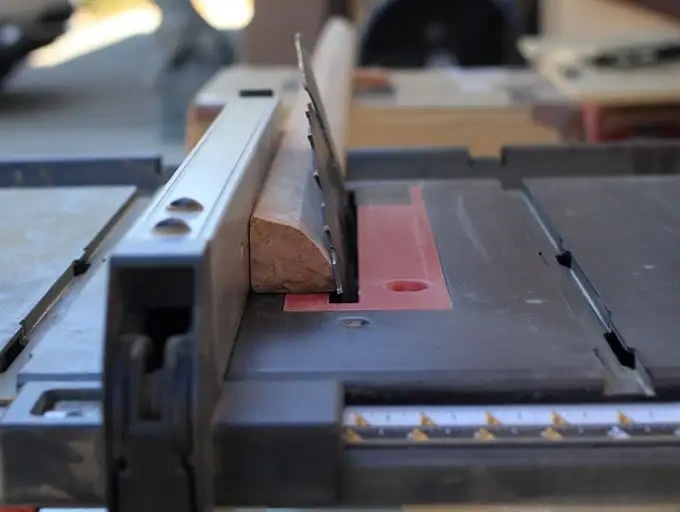
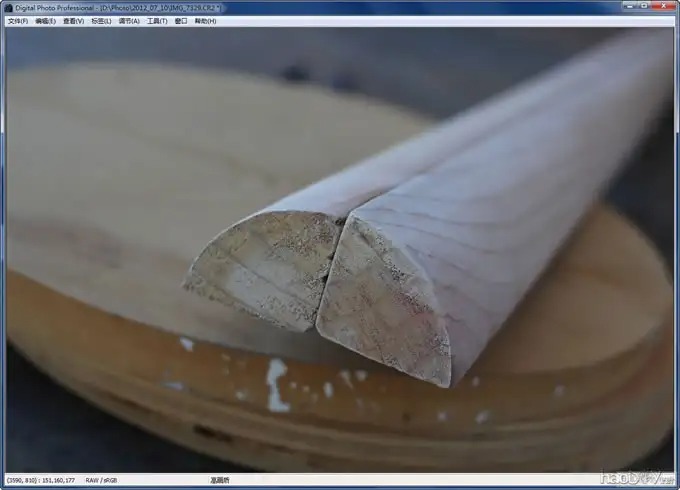
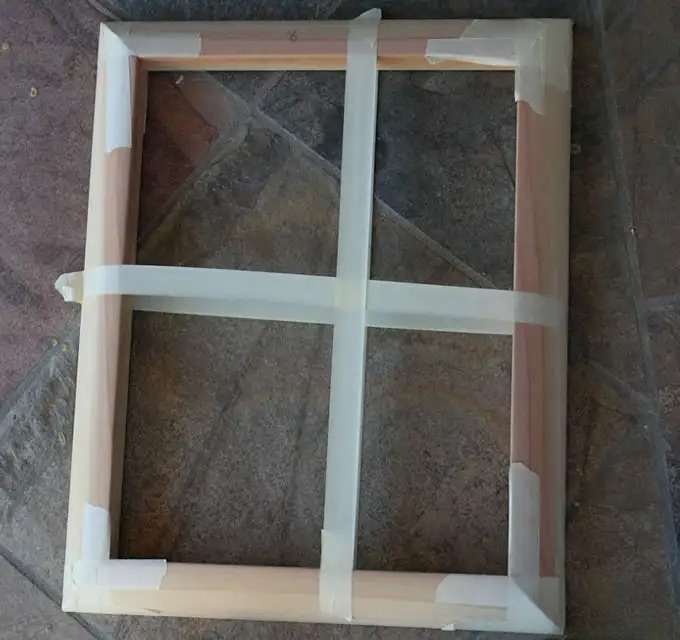
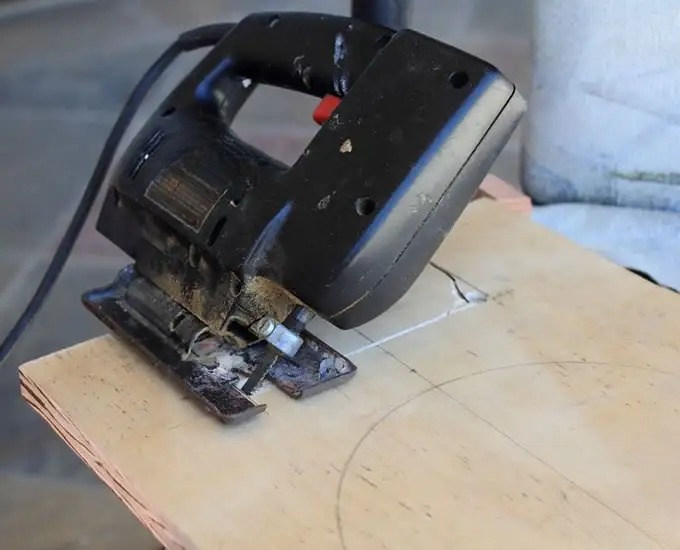
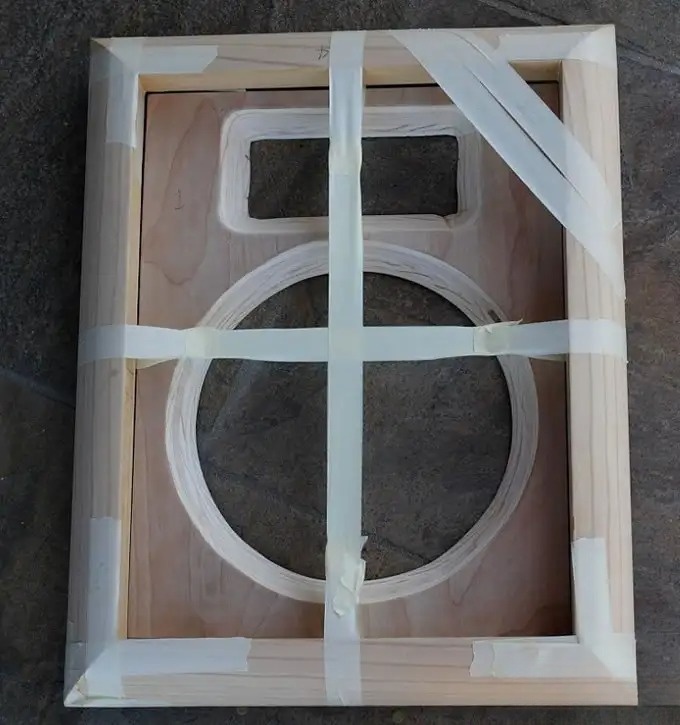
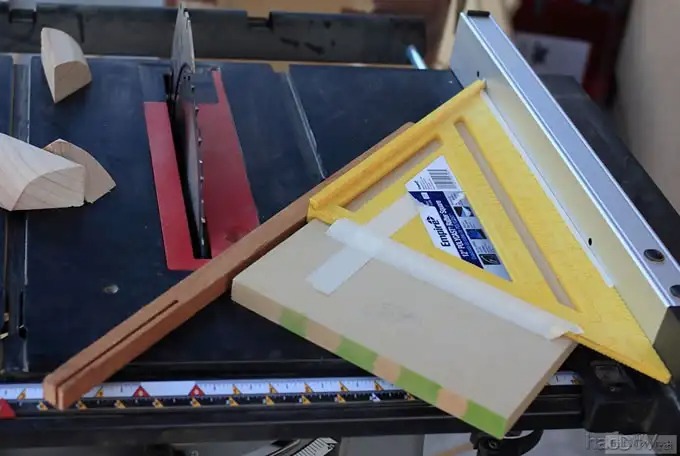
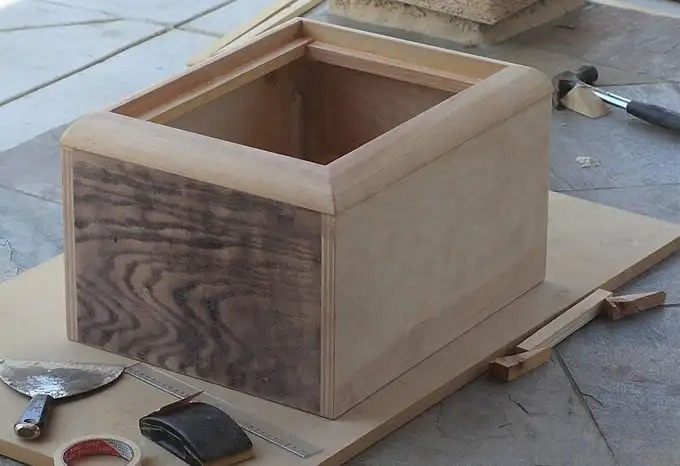
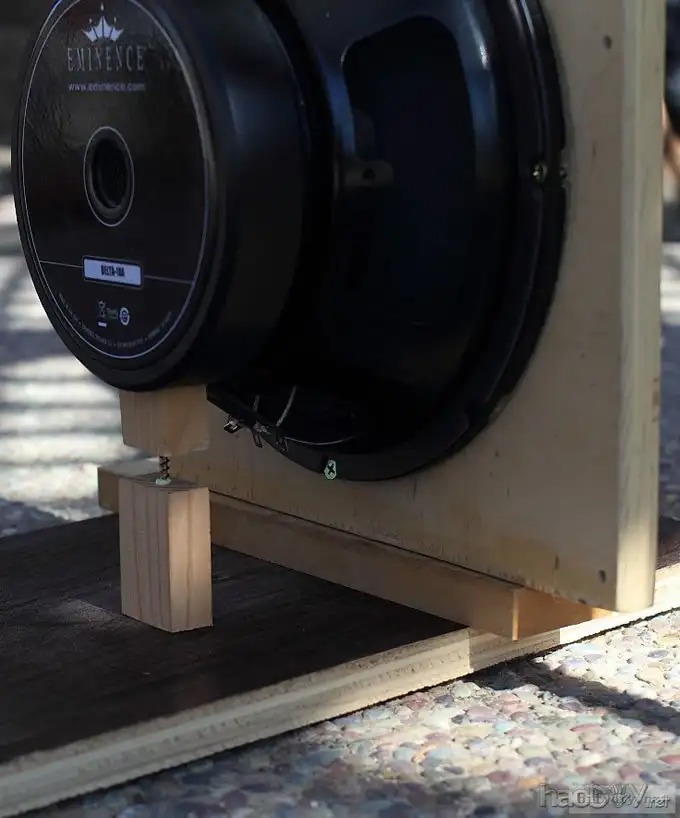
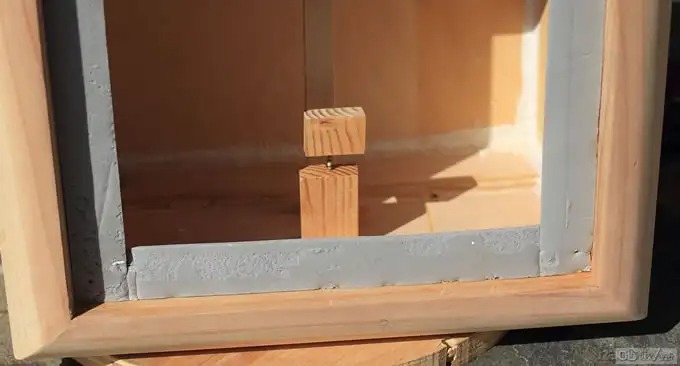
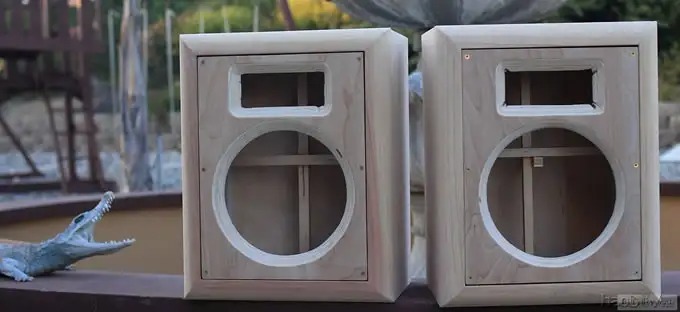
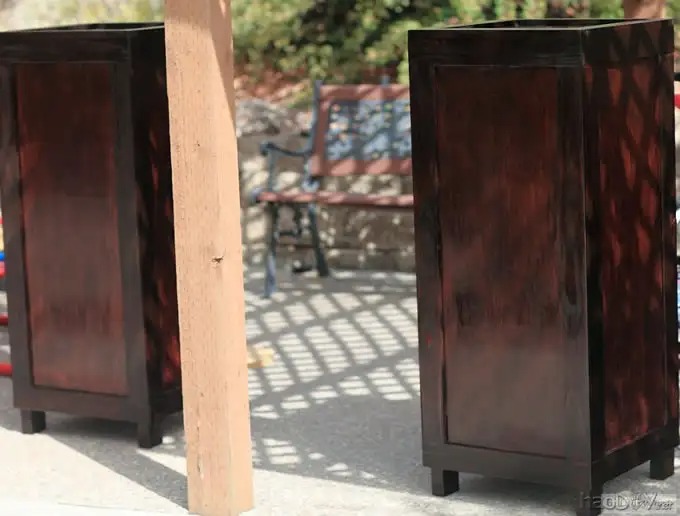

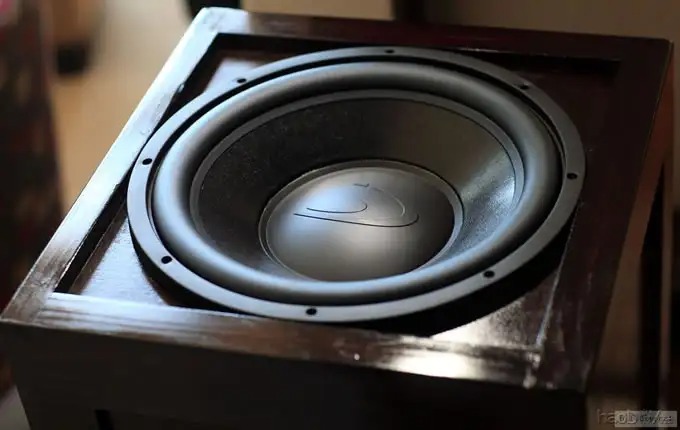
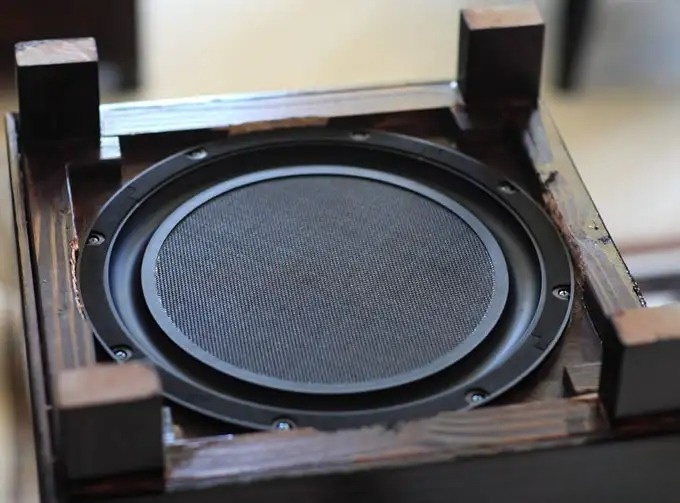
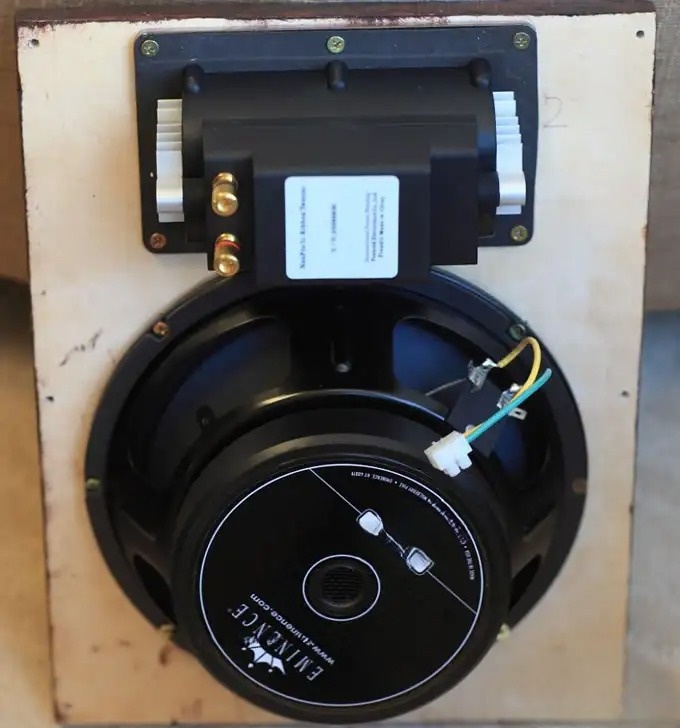

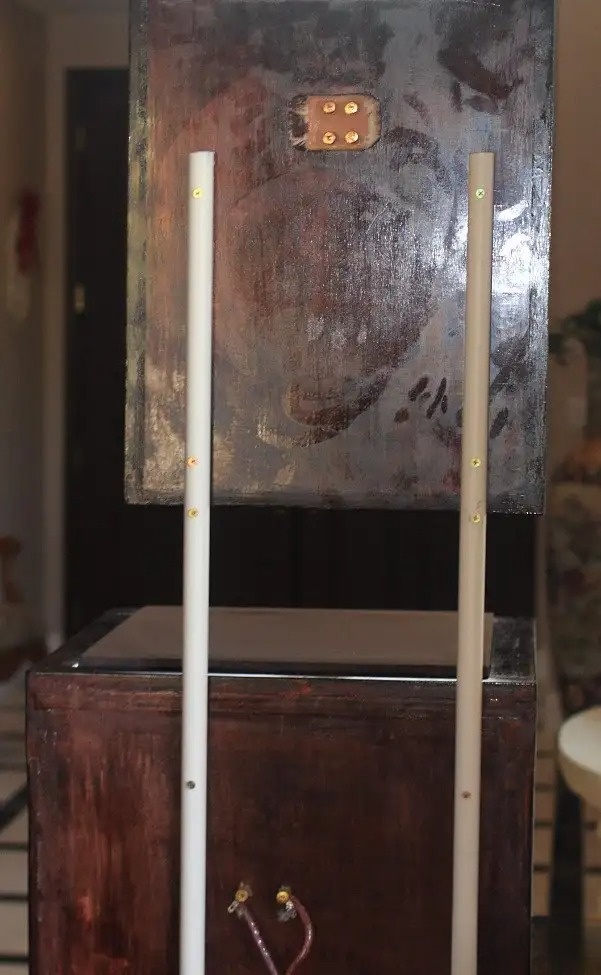
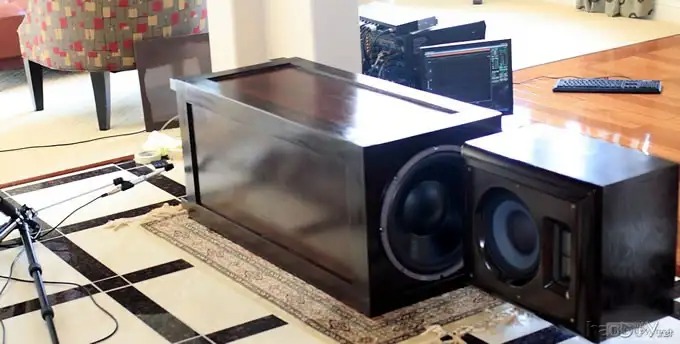
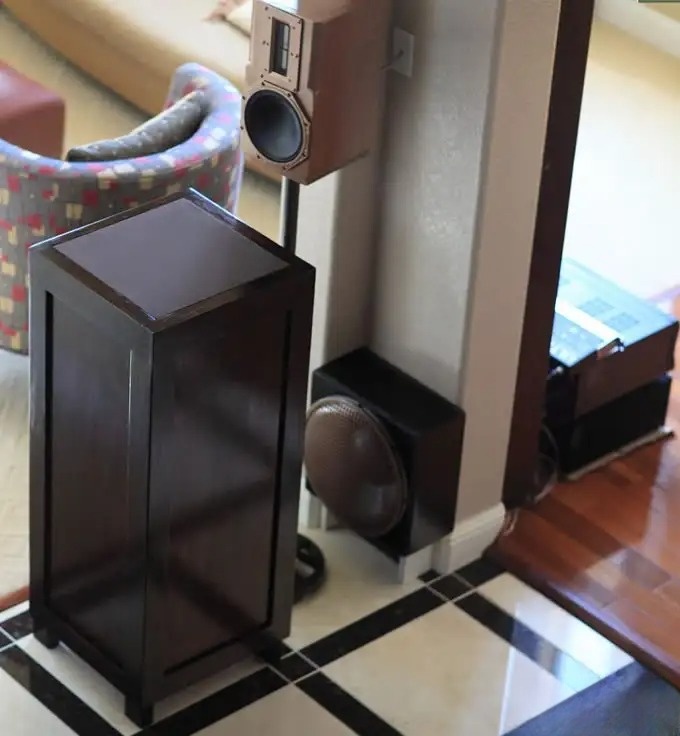
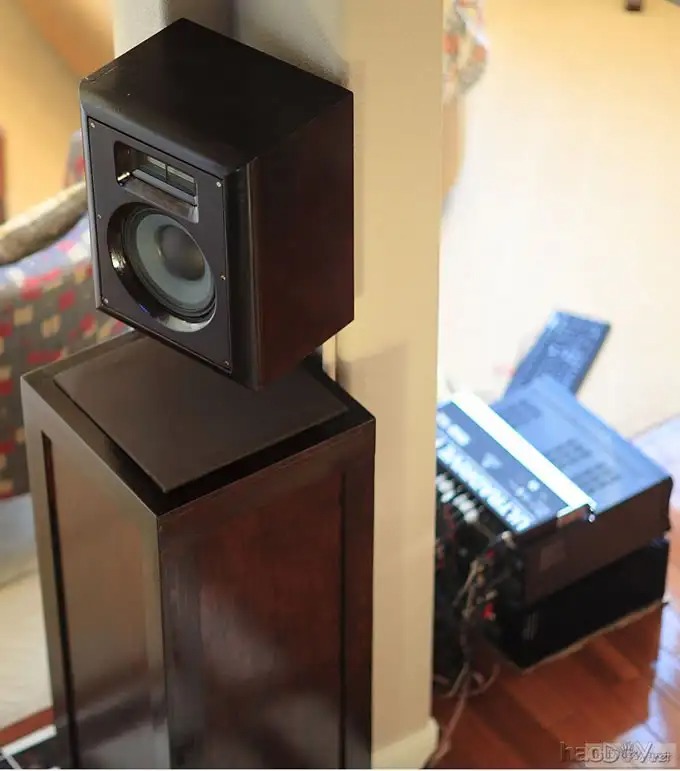
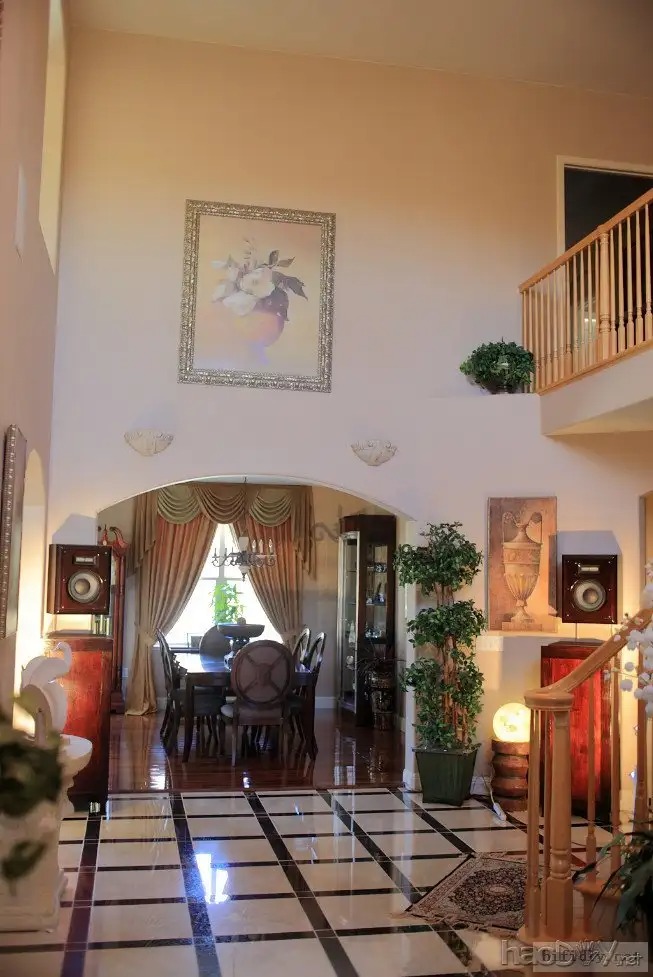
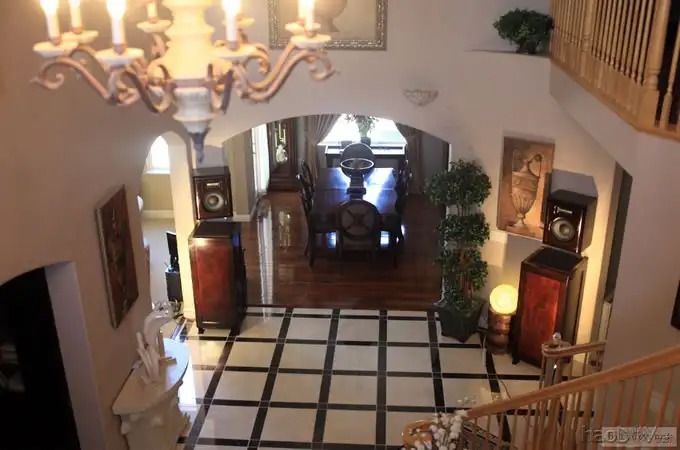
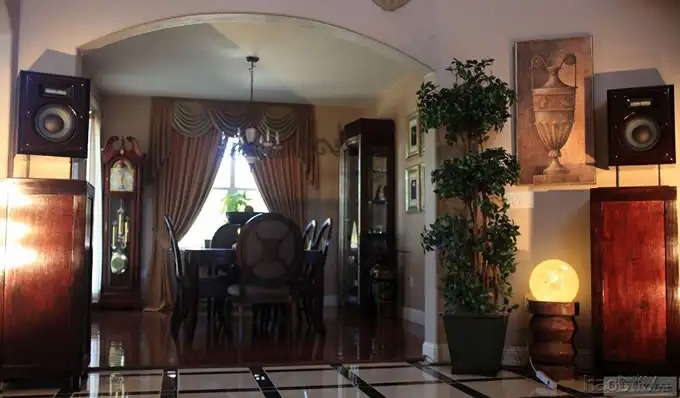
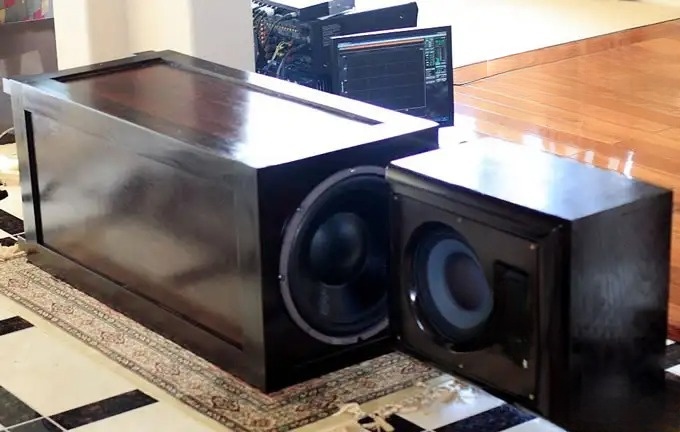

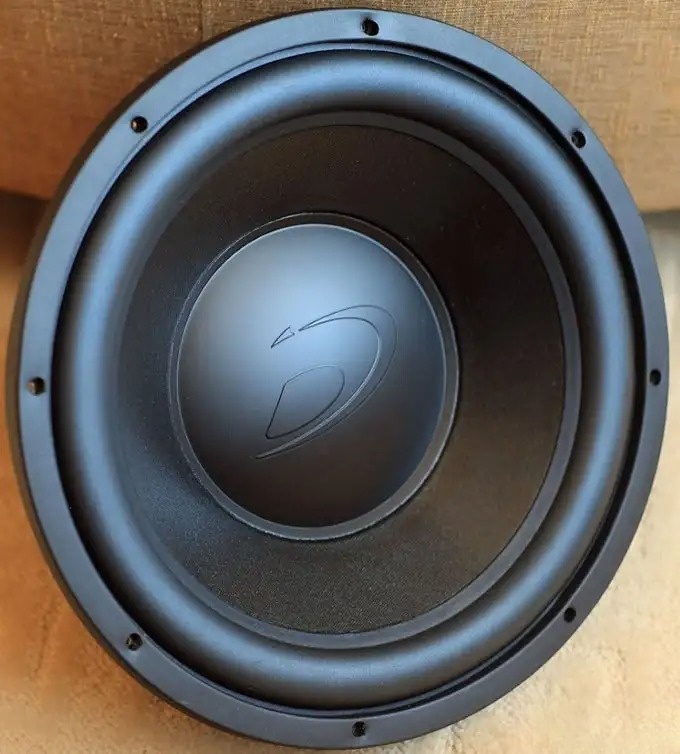
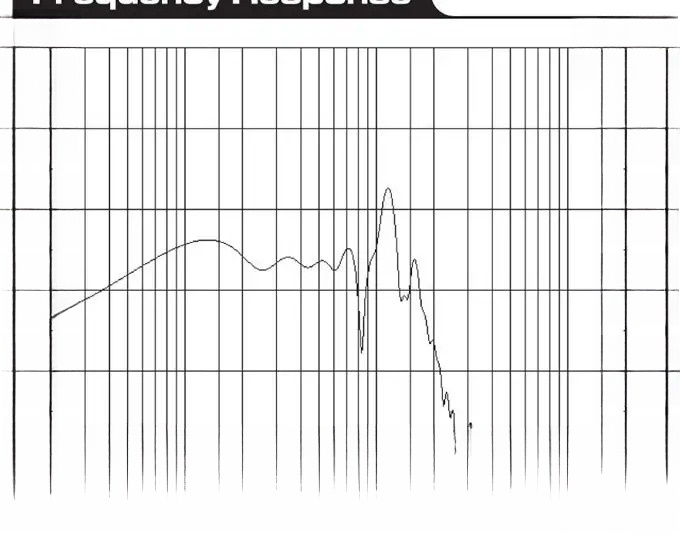
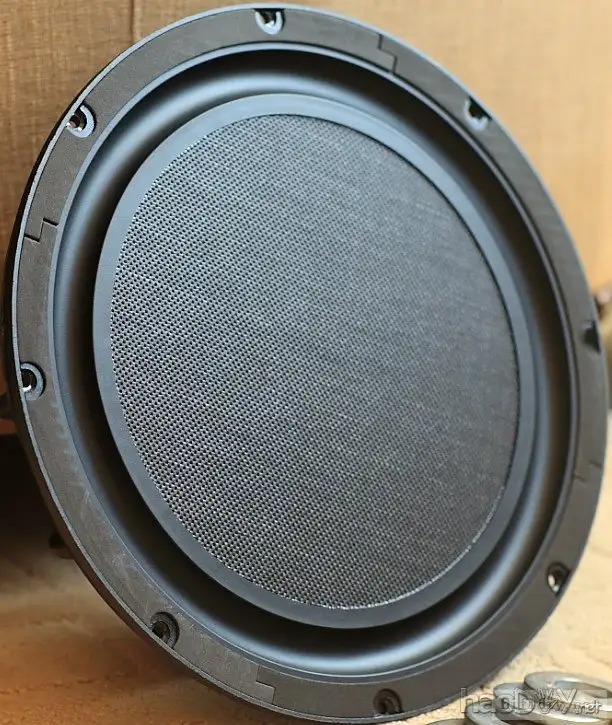
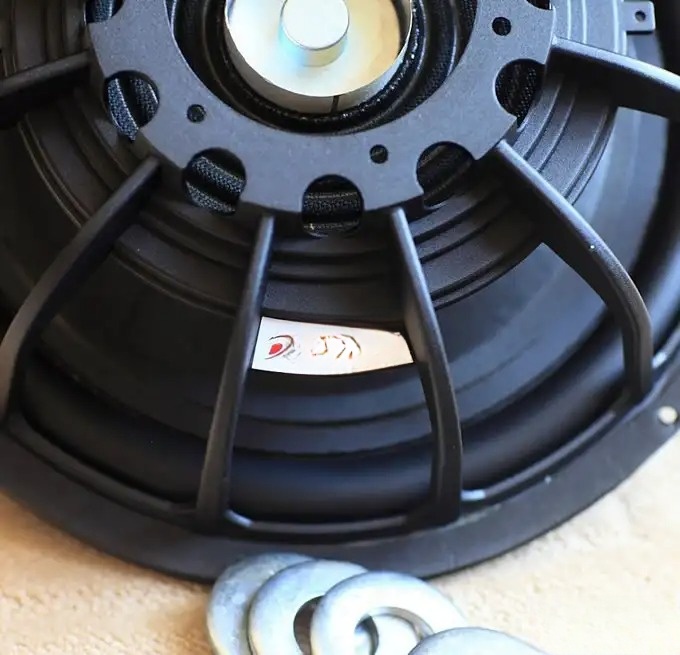
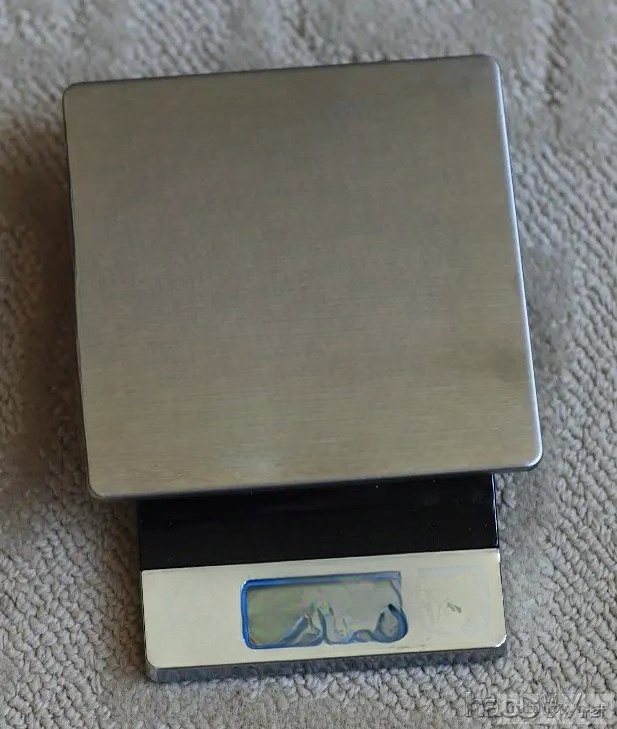
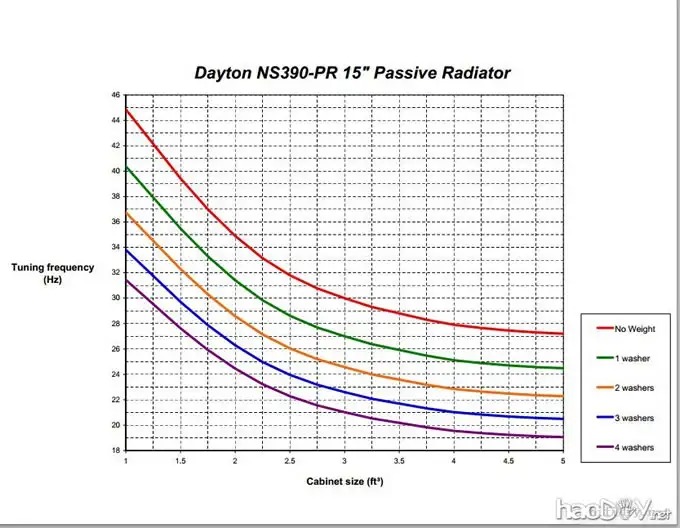
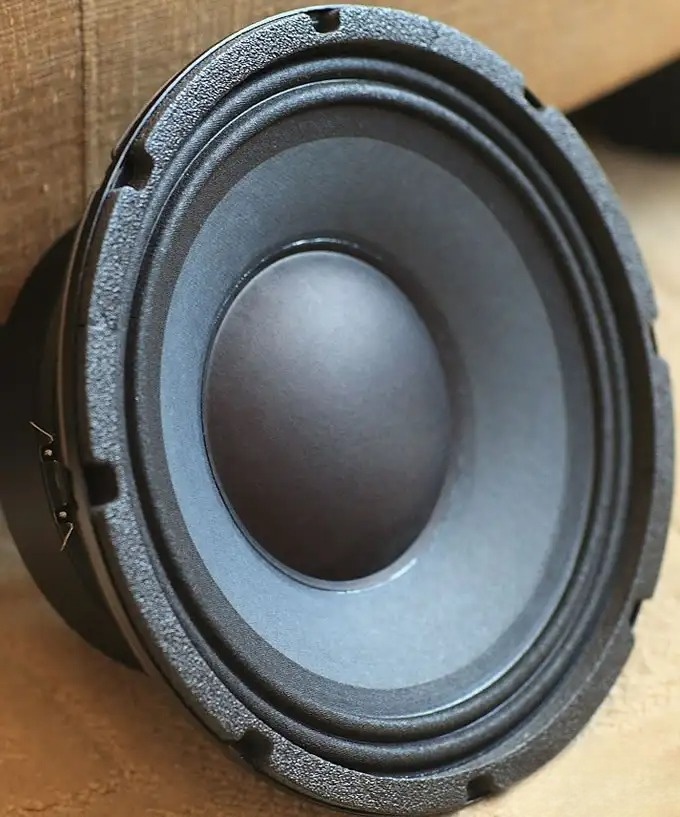
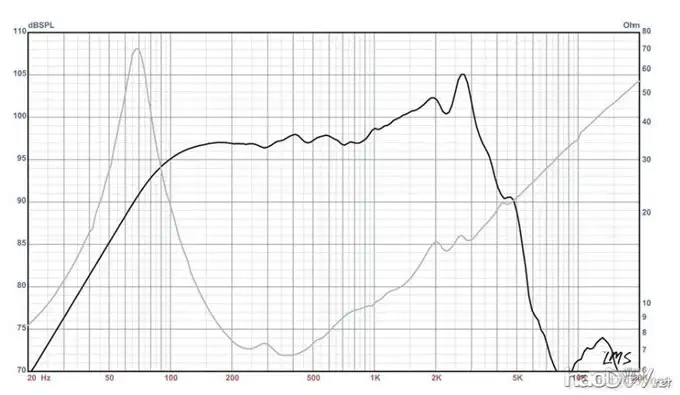
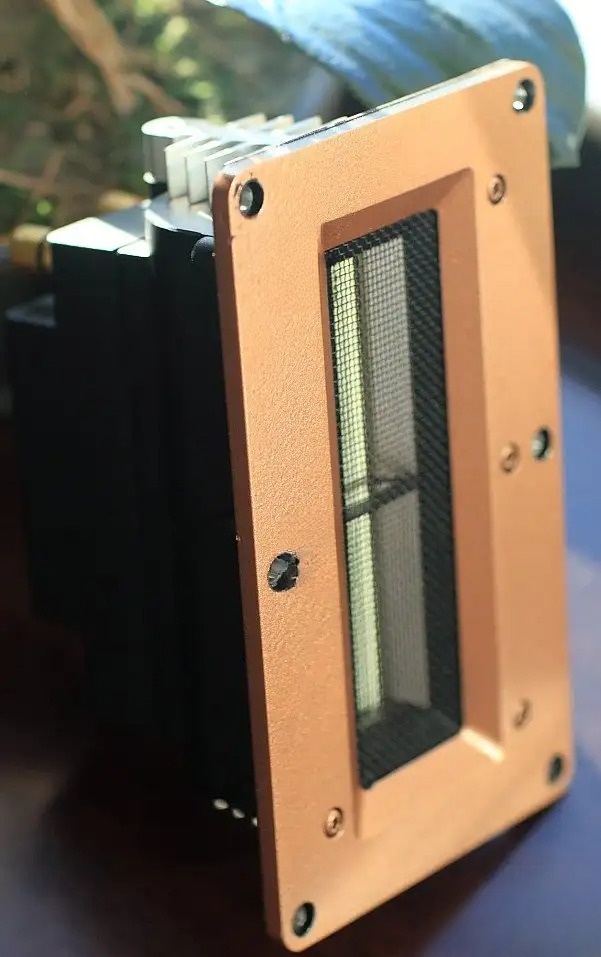
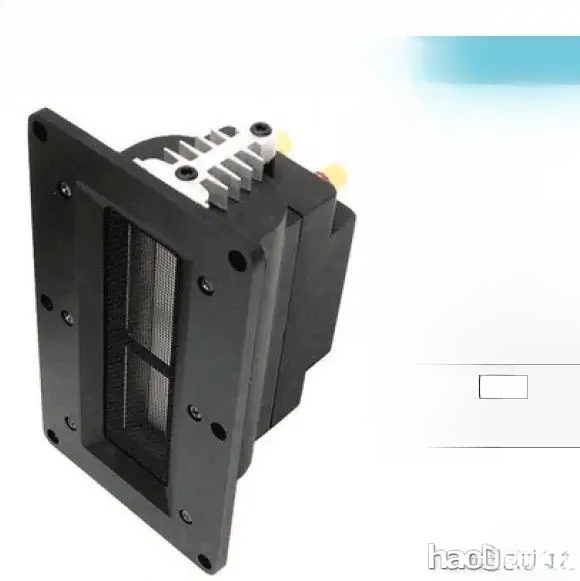
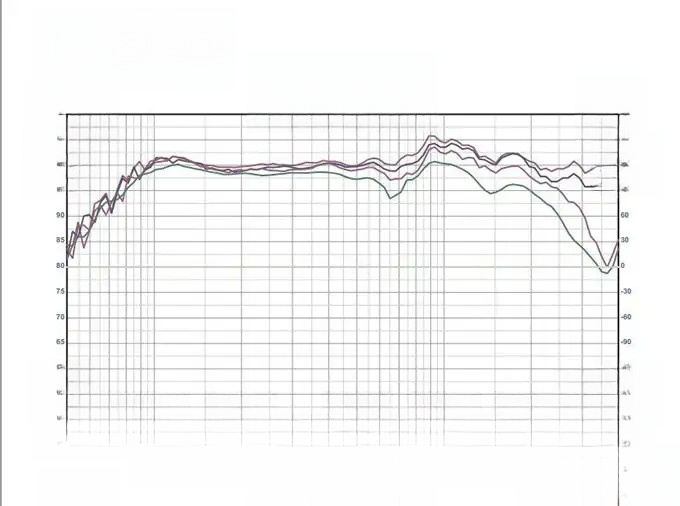

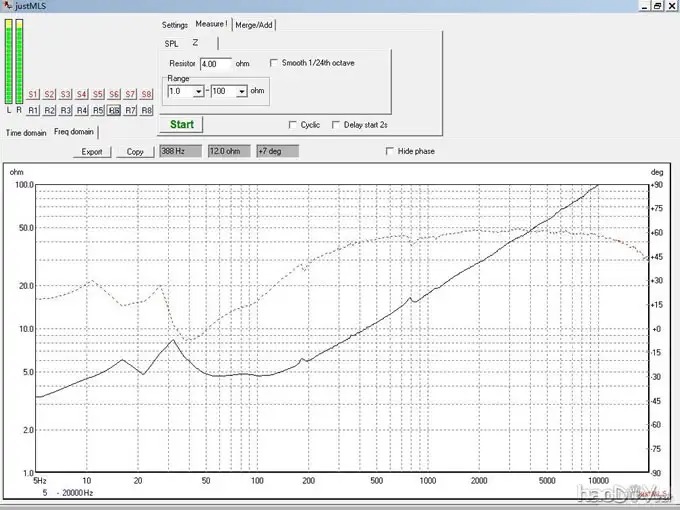
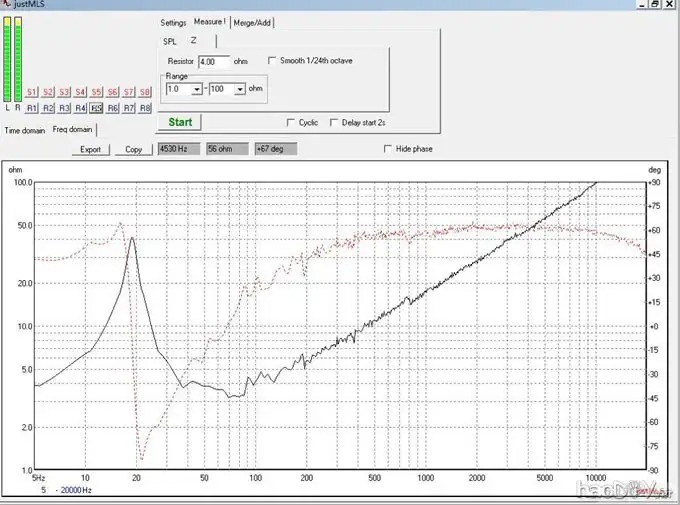
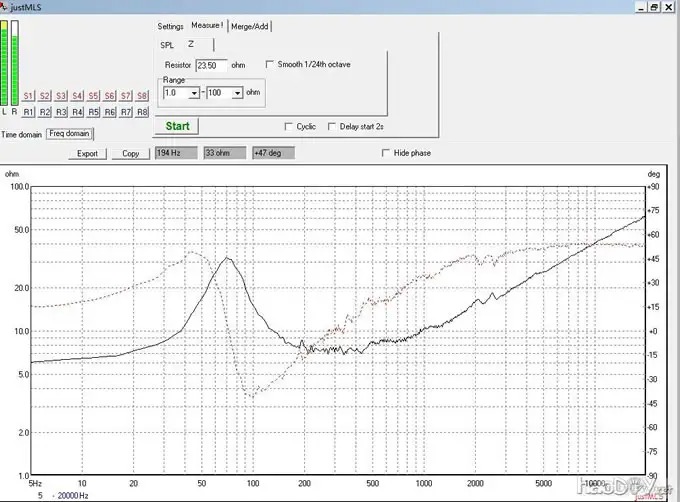
From the free impedance diagram of the woofer on the 102nd floor, we can see that when the speaker is not boxed, its resonant frequency is Fs=18,8Hz. If it is placed in a sealed box of the same volume (100 liters), according to the relationship with Vas, its resonant frequency is calculated to be 32Hz. I adopted the nonsensical principle mentioned above and used an empty paper cone to suppress the resonance. As a result, two small impedance peaks appeared. From the figure, the maximum value is less than 8 ohms, which is much less than the 40 ohms in the free state (the>
The size of the closed medium-sized speaker box is close to the Vas parameter, and its resonant frequency is close to the resonant point when there is no box. At this time, the crossover point is higher than the resonant point, so that the working frequency band of the speaker avoids the resonant point, so...,,,,,, needless to say?!
Friends, if you want to make a good box, you must understand this.
First, the frequency response diagram of the three-way frequency response is shown; it is measured at one meter from the speaker, without using a time window, and it is all real-time. The starting point of the horizontal coordinate frequency is 20Hz and the ending point is 20KHz.
The microphone is not corrected by adding correction parameters, and the 20Hz correction is as follows:
19.95Hz -3.09db
25.12 -2.08
31.62 -1.30
39.81 -0.83 The crossover point 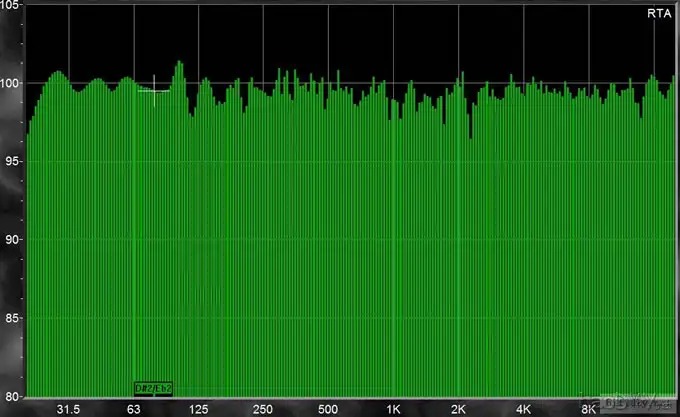 is partially enlarged; detailed test conditions and subsequent analysis. Insufficient carpentry experience, relying on a table saw to build enough (rescue). I have no experience in tuning the box, so I rely on this: DSP (digital D-signal S-processor P) signal processing block diagram; #p#page title#e# partial diagram; Figure 1, Figure 2, traditional crossovers are all calculated through superb simulation technology, and these calculations and measurements are based on the environment of an anechoic room. Therefore, the same box has ever-changing differences in different environments. The following is a quote from a boss who develops speakers on Weibo: Music, Audio, and Life Monday, July 23, 2012 Rebecca /Viva Dialogue with Music Space Equipment (1) – Controversy and Measurement Data The music that people hear is not only related to the speakers, but also to the space equipment. All comments are related to the following factors: the listener's preferences, the standards they are accustomed to, the subjective way of describing the music space equipment . The world is in a state of separation, and after a long period of separation, there will be unity, and after a long period of unity, there will be separation. Because of the above factors, there is no audio equipment in the world that does not cause controversy. The difference lies in: 1) the size of the user group, and 2) whether you are lucky enough to see it. Because of this, it is very important to know how to read measurement>In early 2012, there were some rather controversial comments about Rebecca on the Internet. This is a very interesting example. At that time, I did not publish Rebecca's test>Before the controversial Rebecca was returned to me, I had two different impressions. The first was the controversial comments – box sound, thunder, painful listening. For me, who was familiar with the sound of Rebecca, these comments made me feel that there was something wrong with the system. At that time, I really thought that the Rebecca had a QC problem, and it was very likely that the impedance of the bass unit was wrong. When it came to the next user, something interesting happened: 1) He was surprised that I contacted him 2) He had never read these controversial comments. What's even more incredible is that after reading the controversial text, he said it sounded very good and did not have the problem described in the article. He also added, He felt that the bass was thin in his system (he also emphasized that this was not a bad thing – he was really polite). “Box sound, thunder, painful listening” and “thin bass” are two unrelated arguments. If you don’t know, you will think that they are describing two different pairs of speakers. Of course, I must listen to this legendary Rebecca in person. When I returned to Taiwan in March, this pair was already waiting at home. After measuring the>Confusion is the beginning of growth. I really realized the wonder of music, and "hearing what kind of Rebecca is a kind of fate." This set of legendary Rebecca has been listened to by several Rebecca users and friends who came to buy Rebecca in my home. I didn't tell them that this is the controversial queen. The two friends who came to buy it each took a pair home. One listened to it for two hours, and the other listened to it for ten minutes (I asked him to listen to a few more songs, but he said it was not necessary). This is the wonder of music. There are many variables in the system, and individuals have different comparison standards. Subjective text description is not the best tool to describe the sound. There are various factors. Without objective>Through a certain enthusiastic Rebecca user who contributed his own Rebecca, I asked the magazine to test it. By chance, you can now see the high-resolution Rebecca test>You must be very curious, if the Queen of Controversy is correct, there are many friends who like Rebecca, and the comments they like about her also apply to the Queen of Controversy, then why is there controversy? There are too many possibilities. Maybe the volume is too high and the bass unit hits the side, maybe it's the placement space, maybe it's the owner's evaluation criteria, maybe it's the text description, maybe it's the amplifier, ... You should understand that this is a question without an answer. I really hope this is a pair of speakers with problems, but the test>
is partially enlarged; detailed test conditions and subsequent analysis. Insufficient carpentry experience, relying on a table saw to build enough (rescue). I have no experience in tuning the box, so I rely on this: DSP (digital D-signal S-processor P) signal processing block diagram; #p#page title#e# partial diagram; Figure 1, Figure 2, traditional crossovers are all calculated through superb simulation technology, and these calculations and measurements are based on the environment of an anechoic room. Therefore, the same box has ever-changing differences in different environments. The following is a quote from a boss who develops speakers on Weibo: Music, Audio, and Life Monday, July 23, 2012 Rebecca /Viva Dialogue with Music Space Equipment (1) – Controversy and Measurement Data The music that people hear is not only related to the speakers, but also to the space equipment. All comments are related to the following factors: the listener's preferences, the standards they are accustomed to, the subjective way of describing the music space equipment . The world is in a state of separation, and after a long period of separation, there will be unity, and after a long period of unity, there will be separation. Because of the above factors, there is no audio equipment in the world that does not cause controversy. The difference lies in: 1) the size of the user group, and 2) whether you are lucky enough to see it. Because of this, it is very important to know how to read measurement>In early 2012, there were some rather controversial comments about Rebecca on the Internet. This is a very interesting example. At that time, I did not publish Rebecca's test>Before the controversial Rebecca was returned to me, I had two different impressions. The first was the controversial comments – box sound, thunder, painful listening. For me, who was familiar with the sound of Rebecca, these comments made me feel that there was something wrong with the system. At that time, I really thought that the Rebecca had a QC problem, and it was very likely that the impedance of the bass unit was wrong. When it came to the next user, something interesting happened: 1) He was surprised that I contacted him 2) He had never read these controversial comments. What's even more incredible is that after reading the controversial text, he said it sounded very good and did not have the problem described in the article. He also added, He felt that the bass was thin in his system (he also emphasized that this was not a bad thing – he was really polite). “Box sound, thunder, painful listening” and “thin bass” are two unrelated arguments. If you don’t know, you will think that they are describing two different pairs of speakers. Of course, I must listen to this legendary Rebecca in person. When I returned to Taiwan in March, this pair was already waiting at home. After measuring the>Confusion is the beginning of growth. I really realized the wonder of music, and "hearing what kind of Rebecca is a kind of fate." This set of legendary Rebecca has been listened to by several Rebecca users and friends who came to buy Rebecca in my home. I didn't tell them that this is the controversial queen. The two friends who came to buy it each took a pair home. One listened to it for two hours, and the other listened to it for ten minutes (I asked him to listen to a few more songs, but he said it was not necessary). This is the wonder of music. There are many variables in the system, and individuals have different comparison standards. Subjective text description is not the best tool to describe the sound. There are various factors. Without objective>Through a certain enthusiastic Rebecca user who contributed his own Rebecca, I asked the magazine to test it. By chance, you can now see the high-resolution Rebecca test>You must be very curious, if the Queen of Controversy is correct, there are many friends who like Rebecca, and the comments they like about her also apply to the Queen of Controversy, then why is there controversy? There are too many possibilities. Maybe the volume is too high and the bass unit hits the side, maybe it's the placement space, maybe it's the owner's evaluation criteria, maybe it's the text description, maybe it's the amplifier, ... You should understand that this is a question without an answer. I really hope this is a pair of speakers with problems, but the test>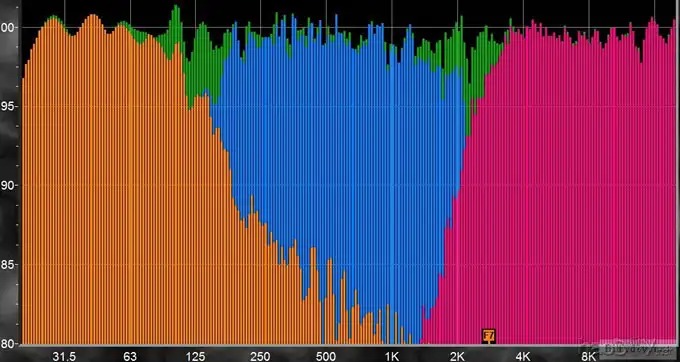
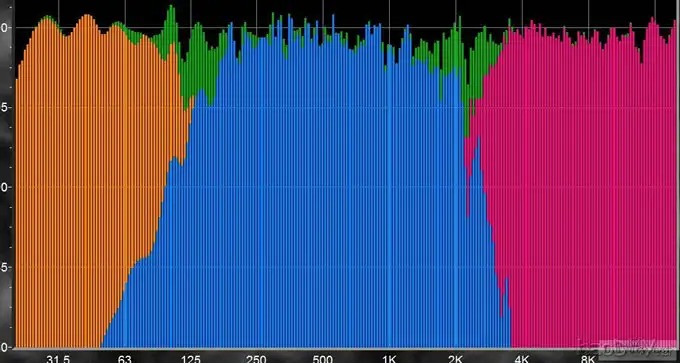
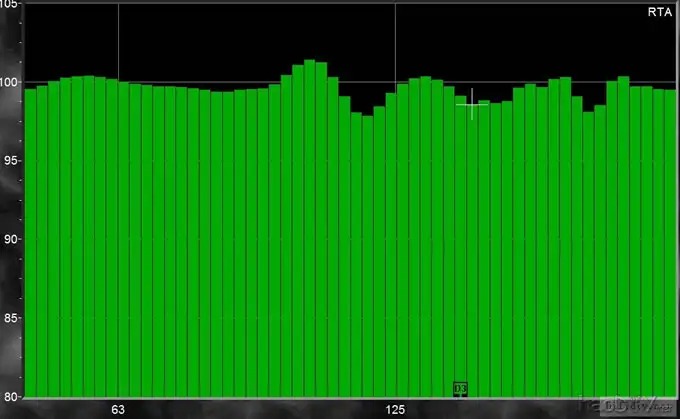
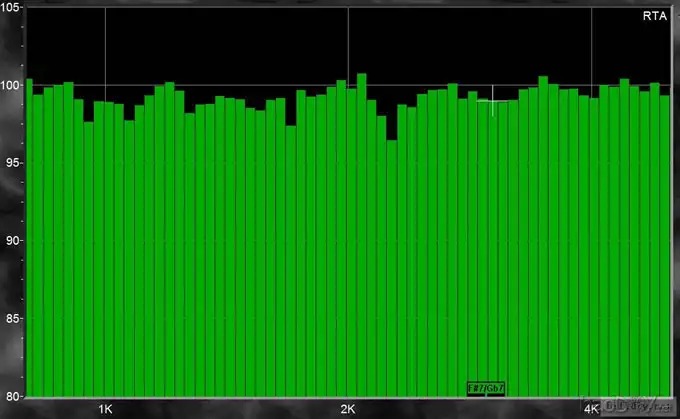
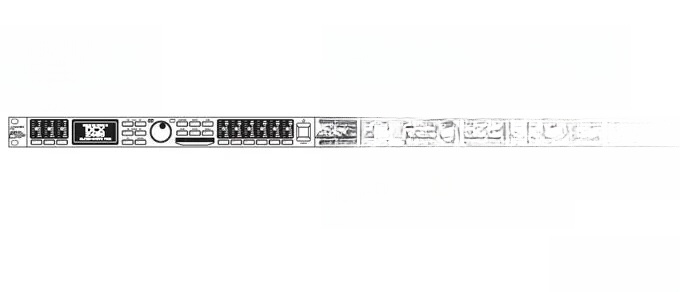
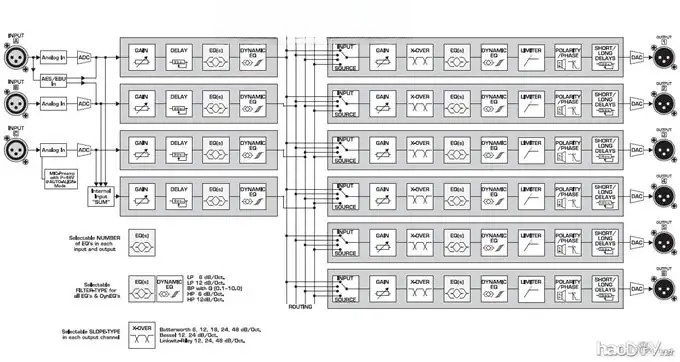
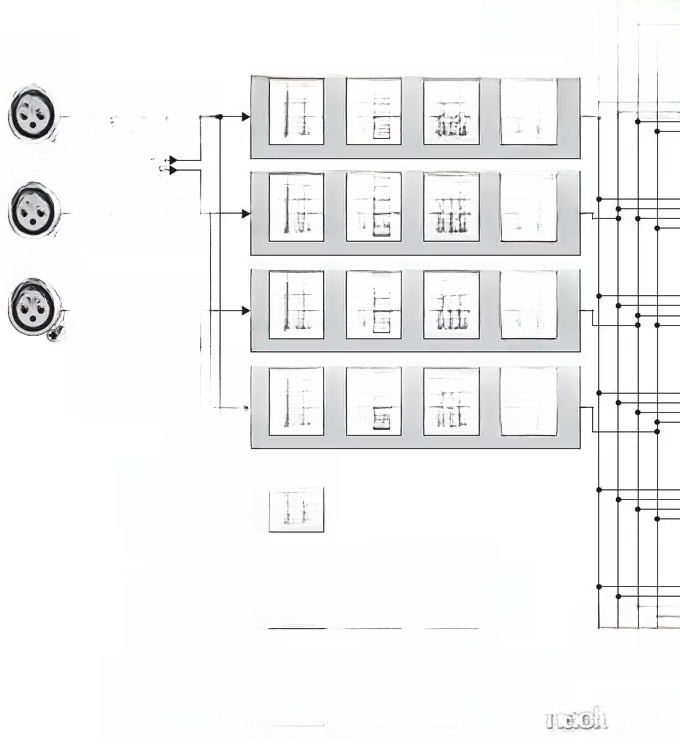
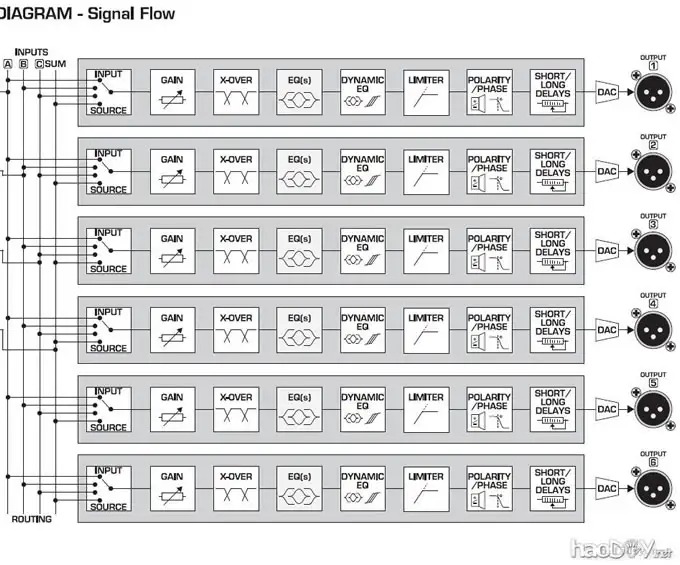
"Dialogue between Rebecca/Viva and Music Space Equipment" will have a series of discussions that "cannot be explained without data". It will make you understand that there are too many variables in music. These topics all come from the enthusiastic response of the Rebecca Community. Without their invitation to the user's home, I would not be able to hear/measure Rebecca's response in so many different combinations of space equipment in a short time, and the same frequency response line can produce so many changes.
At the end of the first article, I will share another story. I know at least six Rebecca users who have or have owned Dynaudio Contour, two of them are floor-standing speakers, and the other is a four-position bookshelf speaker. The comments of the six are "a little different". I have compared one pair myself (vs. Contour floor-standing S5.4). Some said Rebecca has more bass, some said Rebecca has less bass, and some said they are similar. Some prefer Contour for treble, and some prefer Rebecca. Each has its own merits. Friends who are not aware of the situation will think that everyone is comparing different speakers just by reading the adjectives.
I have a lot of stories like this through Rebecca. That’s why after my trip to Taiwan, I think the Rebecca/Viva photo placement will be of real help to users:
Let me tell you how I adjusted the speaker crossover: Under the monitoring of the spectrum software,
1. Adjust the DSP corresponding single-channel gain so that the sound pressure amplitude of the two adjacent speakers is roughly equal.
2. Select the delay function of one of the channels and rotate the knob to adjust the delay parameters of a speaker. When the sound pressure amplitude in the overlapping area of the two speakers reaches its maximum value, it means that the two speakers are in equal phase.
3. Adjust the crossover points of the two speakers in the overlapping area respectively, and select different multi-order crossovers so that the sound amplitude in the overlapping area and the sound amplitude of the two speakers are on the same straight line.
Mission accomplished. At this time, a situation that you may not expect arises: assuming that the crossover point is 2K, at this time, the crossover point of the midrange speaker is 1.68K, and the crossover point of the tweeter is 2.62K. This is because the sound amplitude output by the speaker is not a strict straight line. If you look at the mid-range sound chart I provided above, it is upward at the 2k position. I have to use a crossover and select different orders.
That is, different attenuation slopes attenuate the amplitude in advance to make the two speakers connect smoothly. I bought an electric crossover before, which didn't have this function at all, which was painful. When I think of traditional crossovers, it only reminds me of the advanced shipbuilding technology of ancient times.
I really like this kind of technical discussion. Thanks!
1. For audio frequencies below 80Hz, there is an extra AD conversion, which the human ear cannot hear. If you listen to the individual mid, high and low frequencies, you will clearly hear that the direction of the low frequencies is difficult to discern. When it comes to music, you feel more of the elasticity, softness, and airiness. For AV, it is more about strength and shock... However, this DSP also has digital input, but it lacks a digital analog input. Let's see if there is a chance for digital input. I am using digital input.
2. If it is only used as a subwoofer, it is a very good idea to use an amplifier with DSP. However, in the entire audio system, you cancel a central control and replace it with the DSP attached to the high and medium frequency amplifier as a branch control. This is a bit simplified (annoying). The DSP function is obviously not powerful enough. For example, the maximum DSP delay of the amplifier is only 300 milliseconds, and there are only 8 equalization levels. You should know that the equalizer used will not use the same number of levels for high, medium and low. In addition, such a large amplifier will not be used for tweeters. Mids and highs should use some delicate, high-quality, small-power amplifiers. If they are both delicate and powerful, this is a contradiction in itself, and the price of the amplifier will be much higher. On the contrary, the bass amplifier focuses on small internal resistance and sufficient power, and it doesn't matter if it is a little thick (although active crossover requires multiple amplifiers, their specialization will bring benefits, such as using three-band speakers instead of full-band. Of course, this is said from a different perspective, and I hope you will forgive me). Good steel should be used on the blade, in my humble opinion.
I am also a novice in the audio field, and I have mentioned this in my previous articles, which are well worth a look.
DSP main function display:
Gain of each channel.
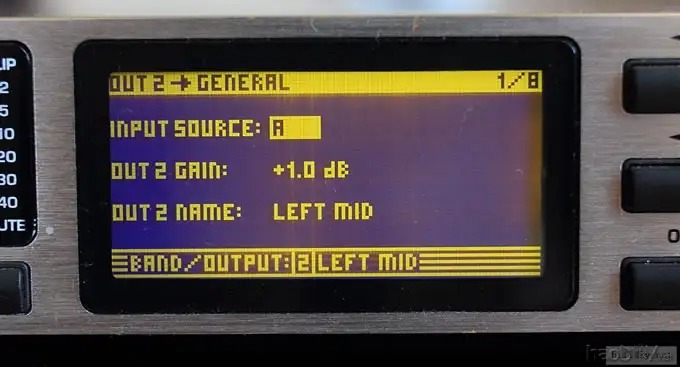
Bass crossover, using BUT48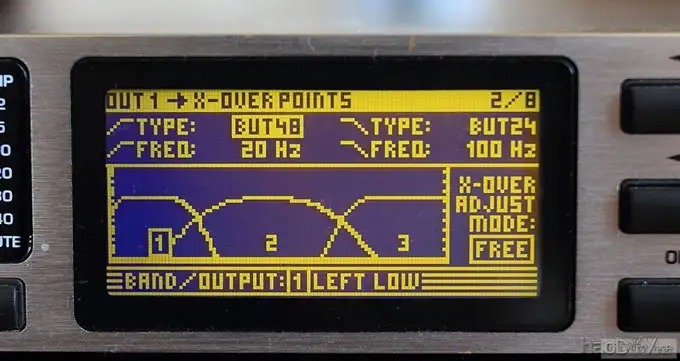
Midrange crossover,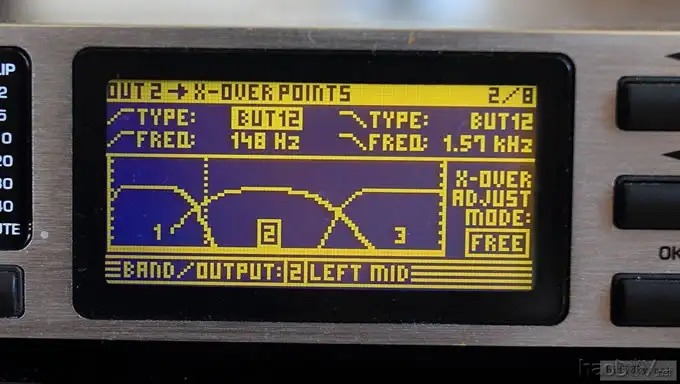
Treble crossover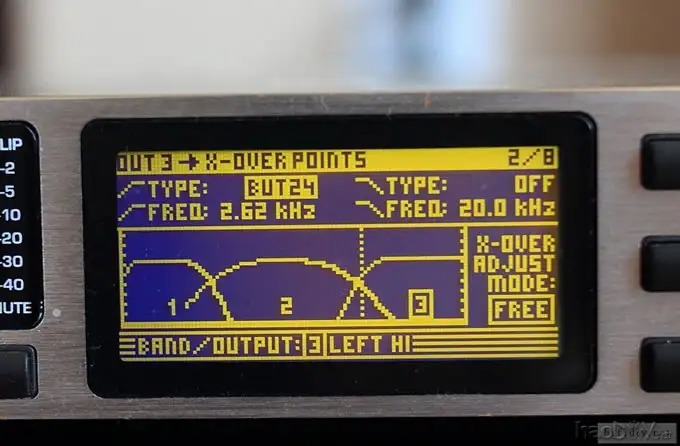
balanced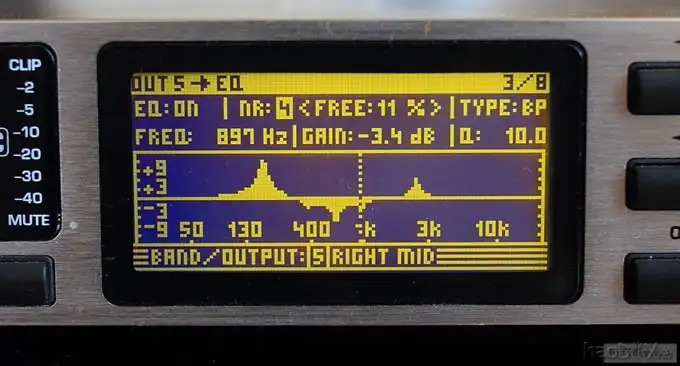
,
Delay,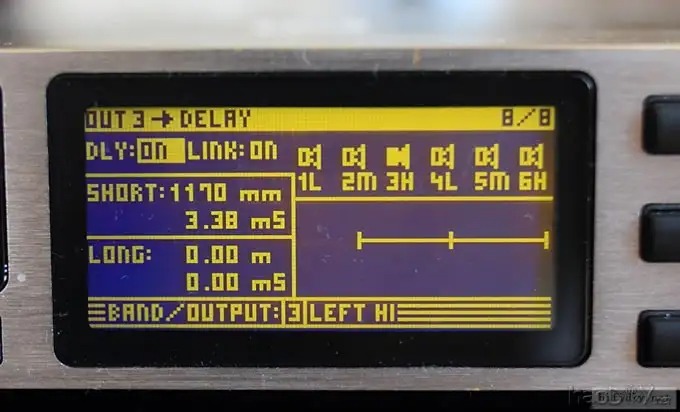
The 6 channels can be opened and cut at will. Very suitable for examining the high, medium and low frequencies of the left and right channels.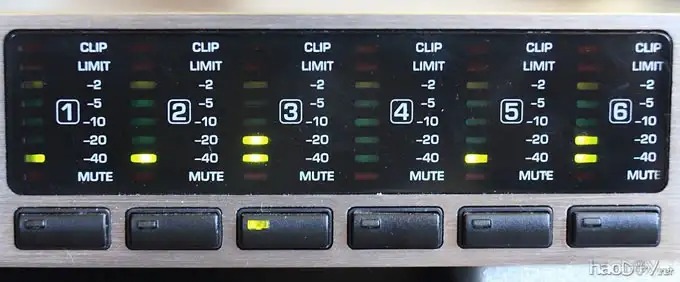
Regarding the issue of sound-absorbing cotton:
I have had two experiences of making bass boxes with bass reflex ports before. Because I also used the same high-power and large-caliber bass speakers, I also needed the bass reflex port to output at around 20Hz. The more sound-absorbing cotton I used, the better. However, this time, due to the use of passive radiation and special box structure, the use of sound-absorbing cotton was far beyond my expectations:
The following only uses the bass output with a 100Hz crossover:
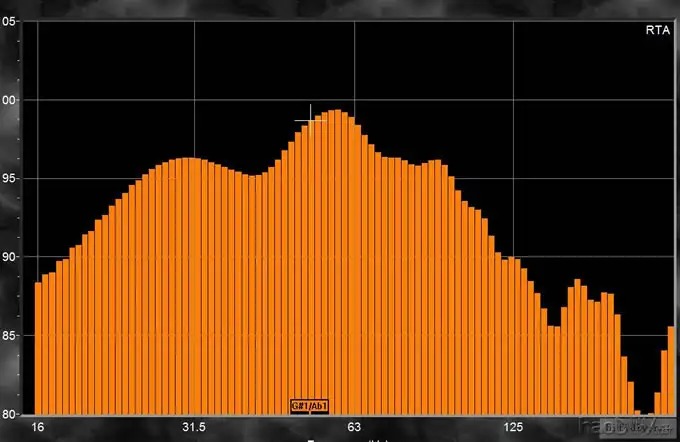
Hold the passive radiator firmly to make the box sealed.
contrast;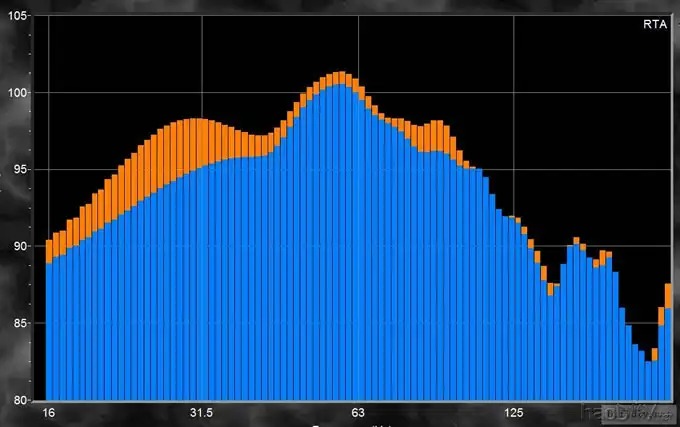
Now you can clearly see the output of the passive speaker. I pre-placed the sound-absorbing cotton with a density gradually increasing from the speaker to the empty paper cone, hoping to reduce the damping of the speaker and increase the output of the speaker. At the same time, reduce the output of the sound frequency that does not belong to the empty paper cone. After several adjustments, in the end, only a layer of 5 to 10 cm of sound-absorbing cotton was placed between the speaker and the box, and the rest was removed. Reasons:
1. From the previous pictures, it can be seen that the empty paper cone is a cone formed by a paper cone and a flat plate, which effectively isolates the sound in the box. At the same time, its oscillation requires greater energy, so it can absorb the energy of the sound frequency that does not belong to its output.
2. There is less sound-absorbing cotton in the box, the box cavity is more rigid, less damping, and the resonance effect is better, and the output of the empty paper plate is significantly increased.
3. When there is no sound-absorbing cotton in the box, the speaker output increases, and the noise waves in the box will also be radiated through the speaker, and the low-frequency output curve is obviously tilted.
The reduction of sound-absorbing cotton increases the low-frequency output of the radiator. This depends on the diagonal baffle in the box, which breaks the four planes and two pairs of balance planes of the box. There is almost no space for standing waves to be generated, which is equivalent to the effect of circular, polygonal, and pyramid boxes. Originally, this box is square, with equal length and width, which is the biggest taboo in making boxes.
Usually, in an audio system, the biggest shortcoming is the speaker. When we listen to music, excluding the parties who feel the music, the biggest shortcoming is the environment in which the music is played. Think about it, the TV has an automatic adjustment function to adapt to the ambient light, and the car has different performance on different roads, sunny and rainy days. Many products have certain usage conditions and environments. On the road, we can drive, the distance to watch TV, the brightness of the environment, etc. Many conditions of the usage environment are relatively intuitive and easy for everyone to control, but sound waves... Almost all speakers on the market are measured in a specific environment. You can see the commonly used box-making software in this forum. Many posts are very particular about the test conditions, and the audio equipment used in industry and profession are almost all installed and debugged by professional audio engineers. But for ordinary users, the environment is very different. This is the situation described in the blog post I quoted above, which is also one of the main reasons for the war of words among audio enthusiasts. As a product, there is nothing to say about making a box. For personal use, as a reference, and as a competition, there is nothing to say. #p#Page title#e#But as a box used in known actual conditions, it is still used in an anechoic room in the final debugging. It simulates the anechoic room conditions for testing. It is really a big misunderstanding.
The picture below shows the microphone at the listening position. It forms an equilateral triangle of 3.55 meters with the two boxes. Because the microphone is 1.6 meters above the ground, due to the shooting angle, it seems that the microphone has moved forward.
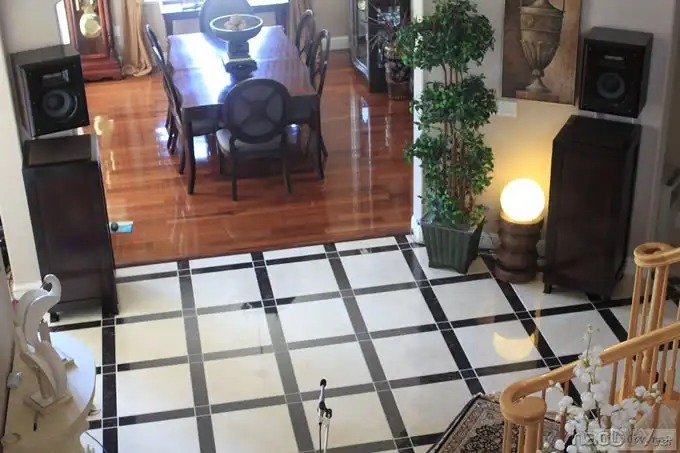
The orange color in the picture below is the output when the right speaker is about 50cm away from the wall, the red color is the output when it is close to the wall now, and the green color is the output after it is leveled with EQ and matched with the midrange;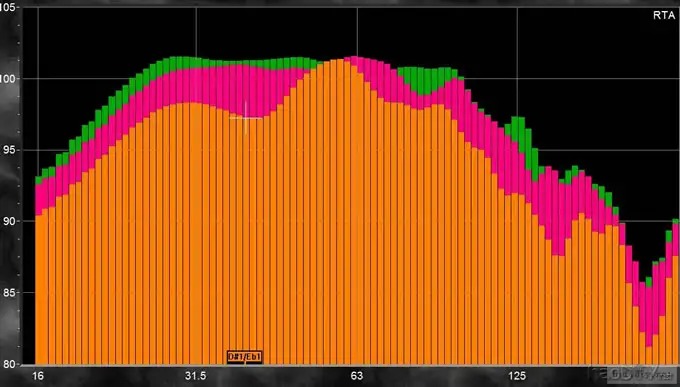
The picture below shows the output of the left bass box with the same color as the picture above;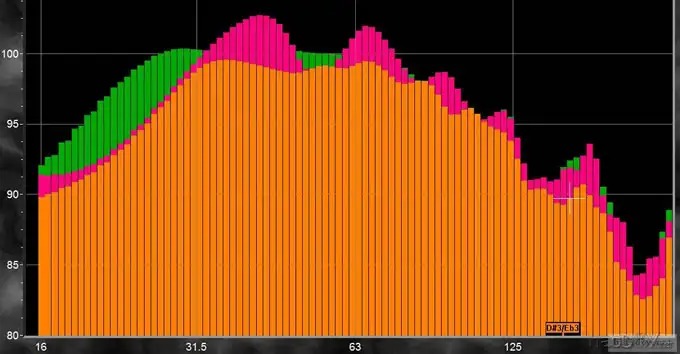
It is obvious from the above two figures that;
1. The left and right speakers have different low-frequency outputs because they are in different positions (it has been determined in advance that the performance of the two speakers is the same, because the left speaker is close to the central hall with a carpet, the low frequency is absorbed a little and the reflection is less).
2. After the two speakers are placed against the wall, the low frequency is significantly enhanced. The wall on the left is almost a pillar, and the reflection surface is much smaller, so the low frequency increase on the left is less. I know from the final debugging that the gain of the left speaker must be 2db larger than that of the right speaker to make the output consistent.
This shows the difference between placing the subwoofer away from the wall or against the wall. And these walls are gypsum boards, which are definitely not as effective as brick walls.
Regarding low-frequency measurement, I believe that experts also think it is a very difficult problem. As I explained in my previous post: In a listening environment full of low-frequency reverberation, if you only monitor a certain point, no matter how straight you make the low-frequency response curve, as long as you move the monitoring microphone, the straight line will become a snake again. We listen to music with both ears. If we hear one ear differently, different low-frequency response curves will appear immediately. What does this mean? No wonder many people are not keen on expressing their opinions on the spectrum. Therefore, I think that only when the low-frequency response curve changes as little as possible or even nearly equal within a certain listening range, such measurement parameters are meaningful for reference. My previous post used the waves to understand reverberation; "You all have this experience: on the coast, there are three feet of waves without wind, and the peaks and troughs of the waves rushing to the shore overlap with the peaks and troughs that surge out, forming higher or lower peaks and troughs. There is no calm water surface, while the waves are rippling and the wind is calm in places far from the shore. Because of the physical properties of wavelength, the mid-high frequency is like microwaves, and the bass is like big waves on the shore. Sound reverberation is like this. Therefore, when using the spectrum to measure this reverberation, the curves at each point are very different. As long as you work hard, you can find that the frequency response of a certain point is flat, but it is meaningless. A deviation from one point will change a lot. After that, I have two other places in this house that are more than 50 square meters. I used the Dly subwoofer to measure the frequency response in the corresponding environment. In one place, the low-frequency response is very large, resonating at a certain frequency, and the bass is so rich that it feels very chaotic, while in another place, the output close to 20Hz can't be raised, and the two places When measuring at different points, the curve changes are also large, of course not as large as the change between computers. Finally, we moved to the place mentioned in the first post, that is, the lobby where the speakers are now placed. The test results and test conditions have been mentioned before (first post), so there is no need to say more. After that, Dly two subwoofers of this system were also measured in ten square meters near the listening area. Its low-frequency response is like the low-frequency part of the system spectrum (fourth post). As you can see, if the low frequency produces enough reflection, it must be like a big wave on the shore, with no calm. Now, in the large range of the lobby listening area, the low-frequency spectrum has almost no change, indicating that the low-frequency reflection is not large and cannot form a huge peak and valley addition, just like the sentence, the Yangtze River's back waves push the front waves, and the front waves die on the beach, because the beach is a slow small oblique wave, and the energy of the big waves is consumed in the climb. I am not educated, please allow me to express it in such a petty-bourgeois language. This shows that the surroundings of this lobby absorb a lot of low-frequency energy. " Refer to http://bbs./viewthread.php?tid=613274
Of course, some friends do not agree with this concept, and think that only professional methods such as measuring the reverberation time of each frequency point are feasible. I admit that this is the method of professionals. For me, I have no idea about the time required for each frequency point to reduce 60db to describe the reverberation of the environment. Let's use this rustic method. At most, we can use a more cultural concept to solve it: by adjusting the frequency response curve of the main sound source (speaker), each reflected sound source can synthesize a flat frequency response curve at a certain point. Just like when a force-bearing object is in a state of equilibrium, the resultant force acting on it must be zero. Once the position of the monitoring point changes, the synthesis of the main sound source and the reflected sound sources generated at different positions at this point has already broken its equilibrium state, and it is no longer a flat frequency response curve with equal amplitude at each frequency point. Only in the listening environment, the amplitude of each reflected sound source is small enough, and the frequency response curve of the monitoring microphone at each point is almost only controlled by the main sound source (the reflection of the ground can be regarded as the main sound source). At this time, the frequency response curve of each point is consistent with the main sound source, but the amplitude is different due to the different distances between each point and the sound source.
It seems to be long-winded, and then use the intuitive method: when you see Yao Ming, you can also know that he is a philistine by visual inspection. It is impossible to pick out a taller person than him among every million people. In the post http://bbs./viewthread.php?tid=608644, I described the listening environment like this: Now I will disclose my friend's listening environment
Environment: This is a two-story house covering an area of 22x23 meters (the garage is not included). The lobby is in the center of the house. There is no second floor. It is 6 meters high and covers an area of more than 100 square meters. The highest pyramid in the roof is more than 3 meters (the ceiling is sealed, which is a good low-frequency absorption box). All walls are gypsum boards with a 10-20 cm fiber-filled interlayer in the middle, and the wall surface is coated with uneven plaster. What's better is that there are almost no walls that are balanced with each other, and all the halls and multiple rooms on the upper and lower floors of this house are connected to this lobby, and the speakers are placed in this lobby. This is really a natural listening environment. In fact, in addition to absorbing low frequencies, gypsum boards also allow low frequencies to penetrate easily, making the surrounding listening environment, the upper and lower rooms, and the side halls become an absolute low-frequency trap. So, for low frequencies, this listening environment is equivalent to a listening environment of 20X20 meters, 8 meters high, with sound-absorbing materials all around and on the top. The hard ground, which is a weakness for many listening environments, just reflects the low frequencies emitted from the passive radiator and sends them out from the ground to all directions, without regret, and never to return (exaggeration).
Think about it, where can we find such an environment? As an idle person, I don’t have the opportunity to see a professional audio room. Exhibition halls, audition rooms, and even many audio magazines cannot see it. Of course, the conference hall, the center of the lobby of a large shopping mall, the rooftop, the stadium, the countryside, the vast world, and even some houses also have better listening environments. Unfortunately, few people will put
on audio. No wonder some people who replied to my post suggested that I build a special audio room. They must be used to seeing beautiful photos in audio magazines, a pair of huge speakers placed in a square, low room surrounded by bookshelves... Anyway, the lower the low-frequency energy your speakers can produce, the lower the low-frequency absorption and attenuation capacity of the corresponding listening environment should be. Therefore, even in large concert venues, the frequency cannot be too low. Movie theaters are designed to achieve shocking and exaggerated effects, so of course they will use reverberation to increase the low-frequency energy. Using this method, continue to debug the box. Measure the frequency response of the left and right boxes at different points within the range of one meter behind the listening position, one meter to the left and right, and one meter in front of the two boxes. It is found that their frequency response curves are almost equal and relatively flat. Then synthesize the low frequencies of the two boxes, and the sound pressure amplitude is 6db higher than that of a single box. I thought it was only doubled by 3db. At this time, test the frequency response at different points again, and the results are consistent with the results of measuring a single box. This shows that the frequency response curve of the listening position is correct. You should know that in a very bad environment, in front of a very bad speaker, as long as you are in a certain position between high, medium and low, you can find a very flat frequency response curve. At this time, adjust the delay parameters of either left or right channel until the delay data is effective, and the synthesized sound pressure amplitude begins to drop. This shows that the low frequency is not very sensitive to the delay and phase difference of the left and right channels.
Friends who have the conditions can select two points near the listening position and measure the frequency response for comparison
Regarding the mid-high frequency, the gypsum board does not have a good absorption capacity. It's just that the walls are all uneven plastering. The curved walls and the larger space are obviously diffuse reflection environments. Compared with the low frequency, the advantage is obviously much less.
The orange part of the following two pictures is the frequency response of the mid-range speaker without any treatment, measured at a distance of 1 meter;
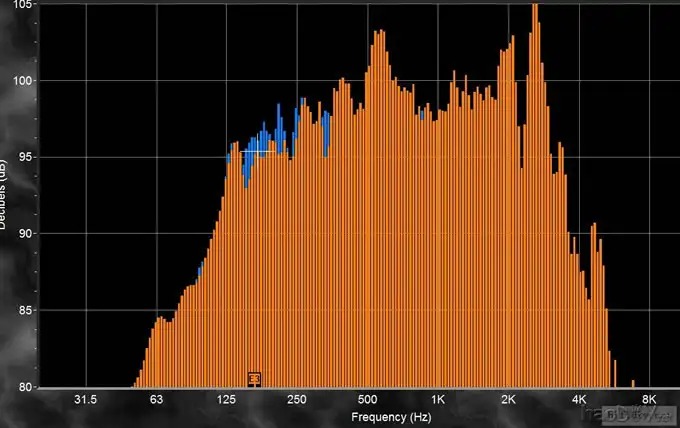
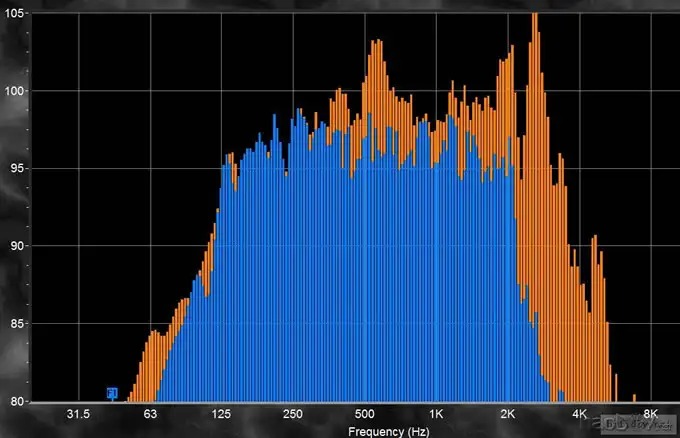
It is worth mentioning here that the high-mid frequency response measured at a distance of one meter, the left channel midrange and right midrange, the left treble and right treble are surprisingly similar, proving that the speaker has good consistency and that the environment has less impact when measured at close distances. Therefore, only one of the channels is displayed.
In the above two figures, the blue part is the frequency response measured at a listening position of 3.55 meters, after frequency division and EQ enhancement, and attenuation. Obviously, it is pulled up near 150Hz, and the high part is cut off near 550Hz, and the other parts are cut off by frequency division.
The figure below is the frequency response diagram provided by the manufacturer, which should be compared with the orange figure above.
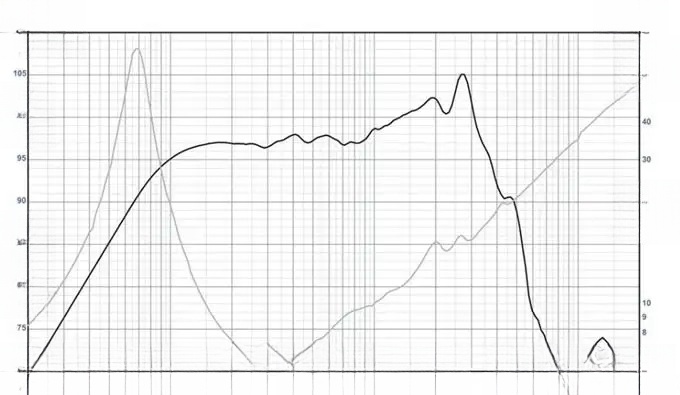
The ups and downs of this graph represent most of the speaker unit's timbre. If we level the output frequency response curves of different speakers of the same grade, make them equal, and operate them in the same frequency band, I think even a golden ear may not be able to tell which speaker is which.
The following figure shows the frequency response of the tweeter at one meter;

There is a valley at 7KHZ, part of which is caused by the loss of panel reflection due to being too close to the midrange.
The figure below is the treble spectrum at the listening position;
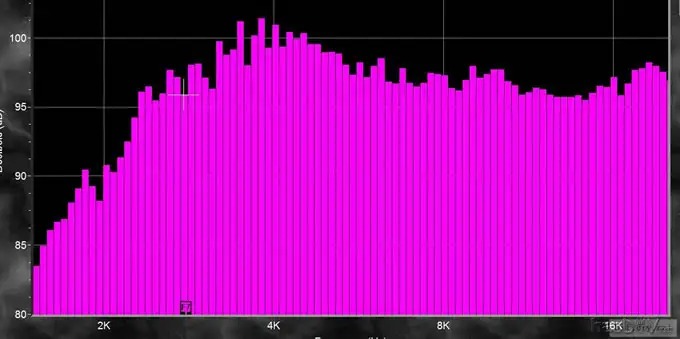
It is obvious that the high frequency end is weakened. Then weaken the small hill at 4KHz. The result is as shown below;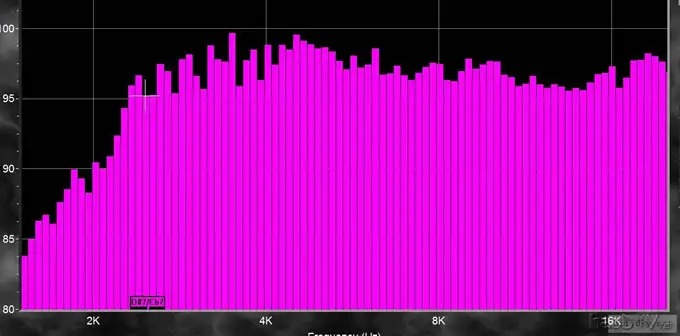
It can be seen that the 3KHz part has burrs, which is the current situation of reverberation interference. Of course, near the listening position, move the microphone and monitor the mid- and high-frequency sounds of each channel respectively, and ensure that they are basically unchanged. Then synthesize the mid- and high-frequency sounds of the two channels separately, and check whether the phase and delay are consistent, otherwise their synthesis will not reach the maximum value, or the superposition will be uneven. The following is the frequency response of different states measured at the listening position: Left channel: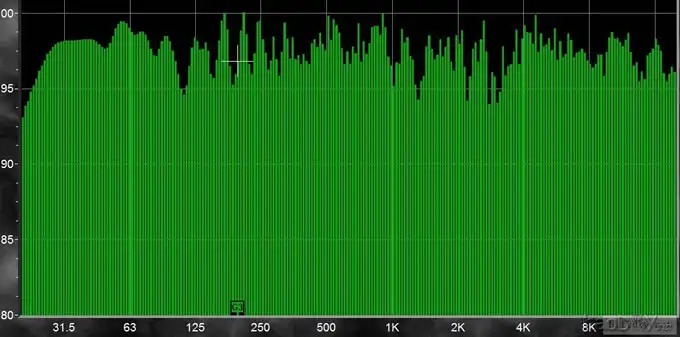
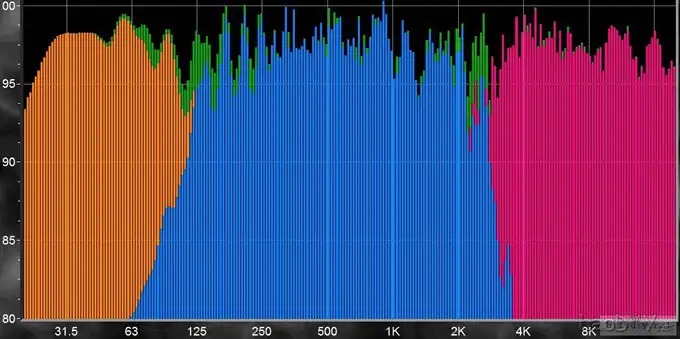
Right channel: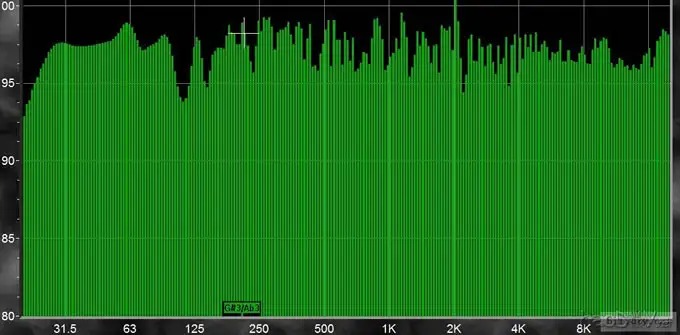
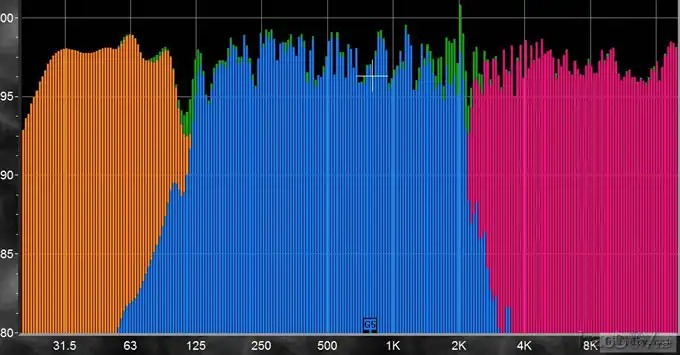
Two-channel synthesis and left and right mono channels.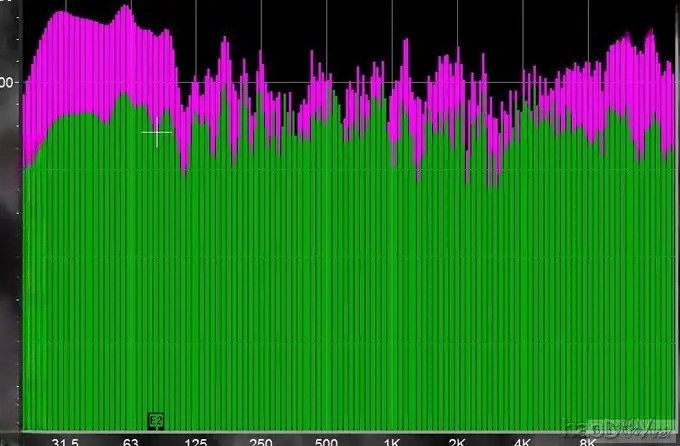
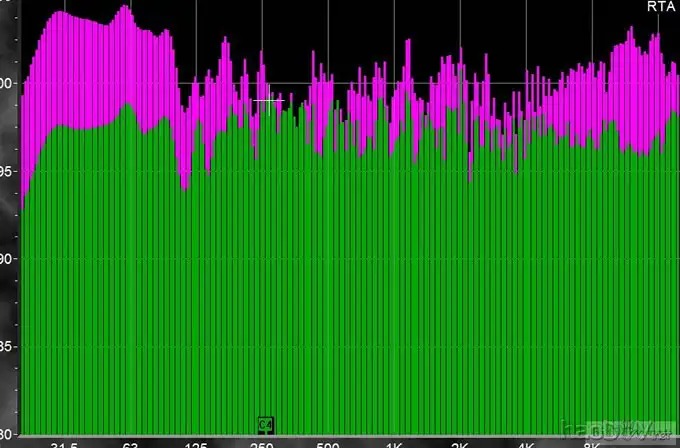
As can be seen from the above figure, after the two-channel synthesis, the two ends of the graph are obviously increased, while most of the middle part is not increased equally. I adjusted repeatedly to make sure that they are in the same phase. Starting from the low end of the high frequency below 6KHz where the burrs appear, there is no equal increase. This should be the interference of the mid-range reverberation. At this time, you can use EQ to make a straight adjustment for the two-channel frequency response. Wait, such an adjustment will be counterproductive. It looks straight, but move the monitoring point. The waveform will definitely change a lot, because each mono channel is straight and has the same phase as the other channel's high, medium and low frequencies. This is why many speakers are measured in an anechoic room or simulated conditions, otherwise they will be affected by reverberation and lose the basis for adjustment. You see, the mono curve is much straighter. This time the speaker placement increases the distance between the listening position and the box by 80 cm. Look at the frequency spectrum of the box mentioned in the previous post, it is much straighter. Look at the frequency response chart at 1 meter posted on the 119th floor before: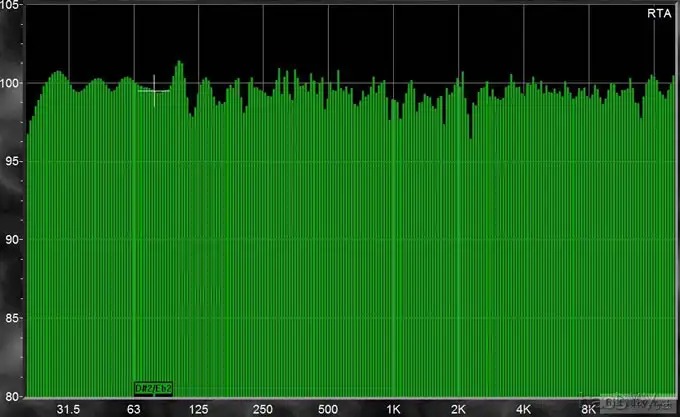
It looks so straight. You see,
The picture below shows me deliberately leveling the treble at a position of about 2.5 meters;
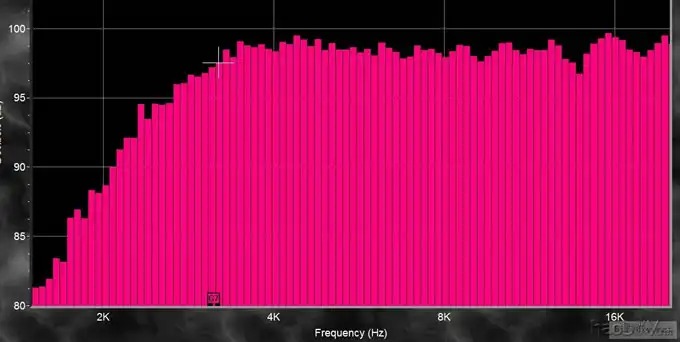
This time, I did not pursue the flatness of a certain point of the graph (because under the interference of reverberation, the flat graph will be unbalanced in high, medium and low), and pursued the balance of high, medium and low frequencies through the relationship between graphs at different positions. Friends, you can measure the actual frequency response near the listening position and see!
Below I provide the spectrum of the left and right channel highs at different distance differences (move the microphone at the listening position, and make the difference in the distance from the monitoring point to the two boxes. If the microphone is moved more than 1mm to the left channel, then their distance difference will be twice the moving distance);
0mm;
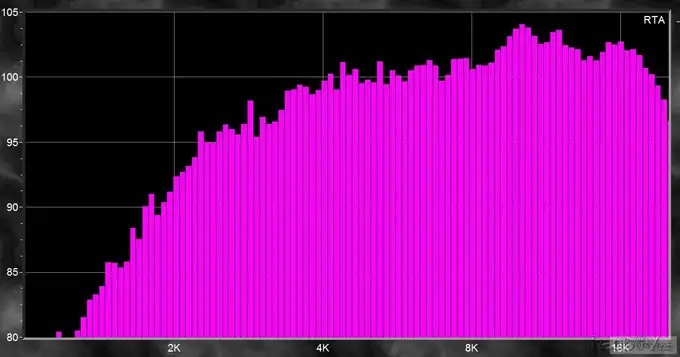
2mm;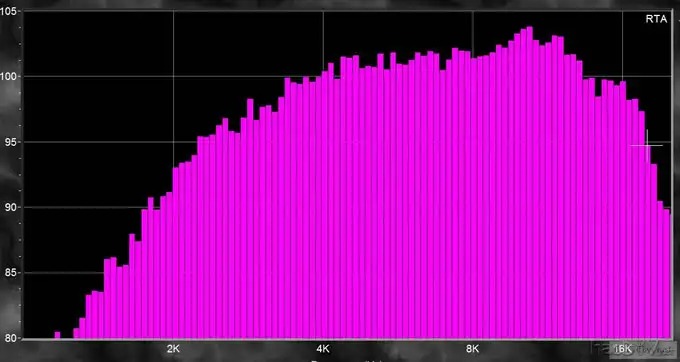
10mm;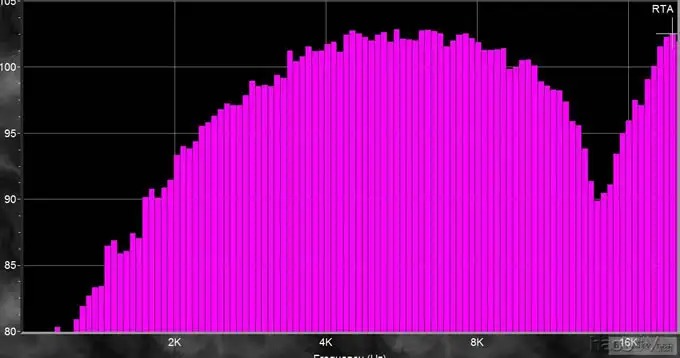
36mm;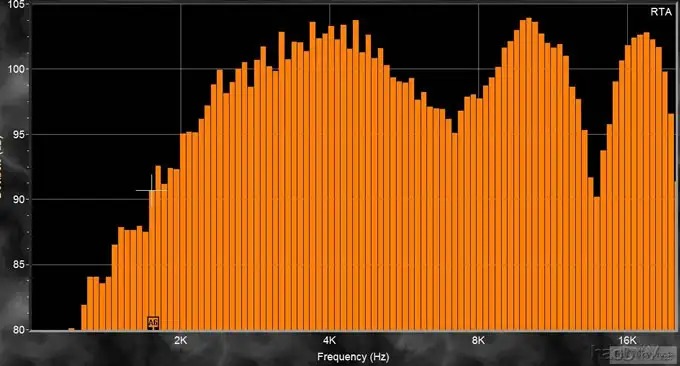
50mm;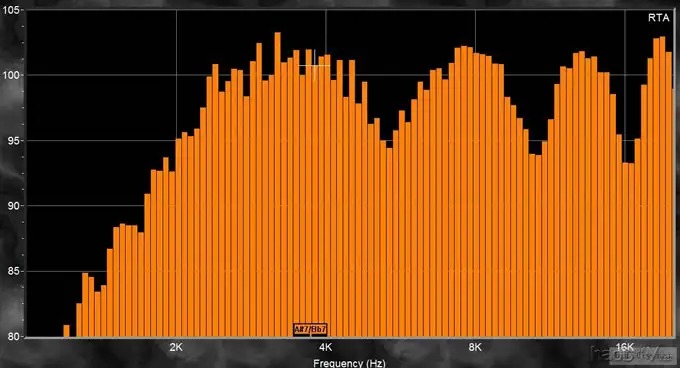
You should know why.
My messy way of thinking and expression, plus most of my friends have never played like this. I wonder if anyone has read all of it carefully. Understand the reason
In fact, this DSP can automatically adjust the phase or delay by sending pulse signals to the 6-channel speakers, and then connecting the microphone to measure the distance at the monitoring position (of course, this function has some shortcomings, friends who need to know can ask questions). I play manually out of interest, and I feel that the audio is like playing with the palm of my hand. A lot of space above describes the use of DSP to make the speakers suitable for the environment. These functions are much more difficult to adjust passively. If it is only for the "Birdtopia" frequency response curve of the speaker, DSP adjustment is easier.
The flatness of the frequency response curve only means that the output corresponding to different frequencies is consistent. If the frequency response at the listening position is taken as the frequency response, the entire audio system, including the environment, has the same amplification factor at different frequencies. Just like the sound source pre-stage and power amplifier, we all require the frequency response to be flat.
Some people say that a flat frequency response curve is for monitoring, and a specific unevenness is beauty. That's right, if your musical accomplishment is higher than that of the person who created the music, and you set a dedicated curve for a specific piece of music, that's beauty. However, if you adjust a curve with inconsistent amplification factors at different frequencies for the speaker to play all the music, I don't have enough knowledge and can't understand it. Fortunately, this DSP can store any number of curves and various combinations of parameters. For example, setting different crossover points, etc., to make the speaker have different effects, you only need one or two buttons to change. It is very suitable for novices (gunmen). Later, I will introduce the design ideas of this box.
Because I want to make a box that is suitable for the environment and rare on the market, the indicator is set at a frequency response of 20Hz-20K (-3db). The sound pressure is >115db. I have tested that the sound near 20Hz can still be heard, but there is no response above 18kHz. In fact, the human hearing range is 20Hz to 20K. How many speakers can meet this basic standard? In fact, the word "high fidelity" is really far-fetched. #p#Page title#e#
For tweeters, I like to try aluminum ribbon tweeters, and its high-end frequency response can easily reach 40KHz, with extremely high sensitivity. Among the high-end aluminum ribbon speakers, there are only a few models, and I easily picked this one with a better price-performance ratio.
Bass speakers: can better output as low as 20Hz, can only be found in the Subwoofers category. The 15-inch speaker is almost the speaker with the largest output and the lowest frequency. And those above 15 inches are all professional speakers. Their sound pressure is large enough, but the frequency dive is not deep. Think about why? In this way, based on the output sound pressure and dive frequency, I can easily find the high-end and high-character speakers in the 15-inch subwoofer. The size of the 15-inch speaker is not small, but for the indicators, there is almost no room for compromise.
For such a speaker with such a large output and low frequency, its vibration is very huge. And for the box, the low frequency is the most difficult to deal with. In order to have greater freedom and high quality, I did not hesitate to use a split structure for low-midrange. Before (http://bbs./viewthrea ... &extra=page%3D1), the output frequency of the inverted box tube of my bass box was a low-frequency infrasound wave that the human ear could not hear. It often made the room behind the box rustle, wasting a lot of energy. In addition, the interlayer of the wall of the house was used as a part of the box. The airflow generated by the sound wave often blew out the fibers and dust in the interlayer. Only passive radiators were used, which could achieve the effect of the inverted box and the effect of sealing the box. In this type of speaker work, the output of the radiator is often larger than that of the speaker. According to Fs and Vd, only the highest-grade passive radiator of the same brand can be selected. Its price is half of that of the woofer. It is not cost-effective for both merchants and users. Do you understand?
In order to better suppress the vibration of the woofer and reduce the noise of the box, I can only use the speaker on top and the radiator on the bottom. In this way, the woofer and the midrange must not be on the same plane. Naturally, there are certain problems in the connection, phase, and sense of direction between the low and midrange. In order to reduce the impact of these problems, try to push the upper limit of the frequency response of the bass box down, that is, the crossover point is as low as possible. Considering the difficulty and quality of the selection of the midrange speaker and the difficulty of making the midrange speaker, I dare not adjust the crossover too low, and it is initially set at around 100Hz. There are highs on the top and bass on the bottom. In this way, the choice of the midrange speaker is clear
Based on my friend's experience, what kind of listening room can achieve the following effect;
Environment: This is a two-story house covering an area of 22x23 meters (the garage is not included). The lobby is in the center of the house. There is no second floor. It is 6 meters high and covers an area of more than 100 square meters. The highest pyramid in the roof is more than 3 meters (the ceiling is sealed, which is a good low-frequency absorption box). All walls are gypsum boards with a 10-20 cm fiber-filled interlayer in the middle, and the wall surface is coated with uneven plaster. What's better is that there are almost no walls that are balanced with each other, and all the halls and multiple rooms on the upper and lower floors of this house are connected to this lobby, and the speakers are placed in this lobby. This is really a natural listening environment. In fact, in addition to absorbing low frequencies, gypsum boards also allow low frequencies to penetrate easily, making the surrounding listening environment, the upper and lower rooms, and the side halls become an absolute low-frequency trap. So, for low frequencies, this listening environment is equivalent to a listening environment of 20X20 meters, 8 meters high, with sound-absorbing materials all around and on the top. The hard ground, which is a weakness for many listening environments, just reflects the low frequencies emitted from the passive radiator and sends them out from the ground to all directions, without regrets, and never to return (exaggeration).
My friend didn't seem to understand what I said. For low frequencies, it is equivalent to treating the entire big house as a listening room. I just didn't use software to measure the reverberation time. As for the dry, dull and other listening feelings, they can all be reflected by the frequency response curve. When the reverberation time is too short, the low-frequency energy of the room is absorbed too quickly, and the natural reaction is that the low-frequency frequency response decreases. But do you see that the frequency response I measured at various points has a tendency to lose its head? I will analyze the frequency response curve and listening feeling later. If friends have carefully read my previous posts, they will know: I have walked out of the prison-like listening room. I am not interested in AV anymore. Now, in hot weather, I can listen to music and run in front of the speakers for an hour.
Let's continue with the selection of mid-range speakers:
According to the formula: the sound pressure amplitude of the speaker output A = sensitivity + 10lg power. Then the bass A = 90 + 10lg800 = 119 (db). The output of the passive radiator has not been considered here. The treble A = 100 + 10lg60 = 118 (db). Assuming that the mid-range speaker also has 200W, the sensitivity of the mid-range needs to be 118-10lg200 = 95 (db) to match the high and low frequencies.
A 200W mid-range speaker with a sensitivity of 95db can only be selected from professional speakers if multiple speakers are not used in parallel and only a single speaker is used.
From this post http://bbs./viewthread.php?tid=609602, we can see that: I previously purchased the highest-end professional midrange in the B&C 8-inch range, with a sensitivity of 97db and 200W.
Figure 1 is the original frequency response.
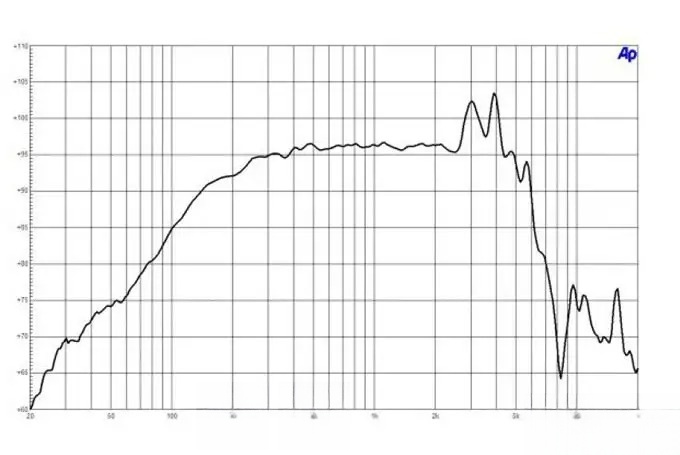
Figure 2: Frequency response after packaging.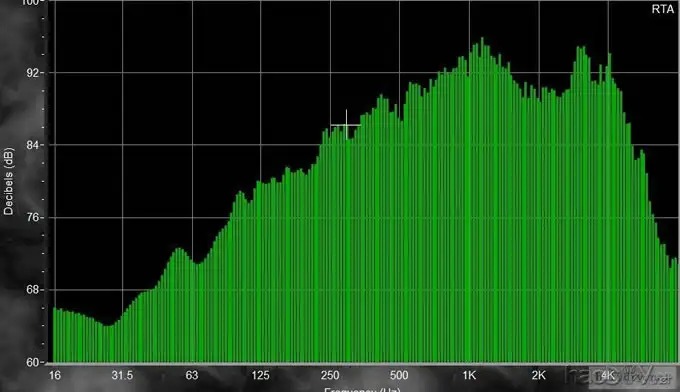
Figure 3 shows the frequency response after crossover and EQ trimming.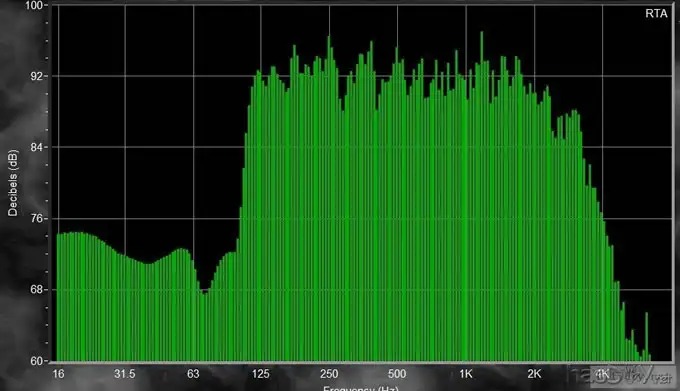
From the three figures above, we can see that I have to increase 10db at 125Hz to get a flat figure like Figure 3 to match the bass and treble. So, for 125Hz, the midrange has a sensitivity of only 97-10=87db. Because 200W is enough power, there is no problem in actual use. But the margin is much less, which makes me feel very unhappy. Maybe it is because I thought 250Hz in Figure 1 was 150Hz when I ordered it. This is also one of the reasons why I redid the speakers. However, this also shows that high-sensitivity, high-power speakers have more space to match adjacent speakers (thanks to the easy adjustment of DSP). This time, I chose this 10-inch Yimeili (thanks to my friend for letting me know the Chinese name of this beautiful) without hesitation. It has a sensitivity of 98.8db and an RMS power of 350W.
I would like to emphasize that a speaker with a sensitivity of 99db requires 16 times less power to output the same sound pressure as a speaker with a sensitivity of 87db. In this way, for a speaker with high sensitivity, its amplifier and speaker can work easily and its distortion is naturally much less. Of course, this kind of high-sensitivity speaker must ensure that the quality factor and distortion rate are not sacrificed as a prerequisite.
Many of my practices are unconventional and unconventional. I used a DSP, which is equivalent to electronic frequency division in terms of frequency division, but in terms of phase control, digital delay is used, which is equivalent to 2 channels, and each of the three groups of 6 speakers can move forward and backward by one millimeter to align the position. I explained the problems that friends are worried about one by one with words and spectrum above. Maybe I didn’t express it well and didn’t make friends understand. In order to avoid making a blind study, I bought JBL's SRL6328P and the Psb flagship box I had before for comparison. Both boxes are well-known. If my Dly is not as good as them, why should I leave them idle? You can see from my previous posts. But no matter what, I still can't let you listen directly, which is a pity. I hope you can understand and feel it from many details.
I also hope that more knowledgeable people can point out the problems from the technical point of view, which is also the intention of writing this post to start a discussion. Thank you again!
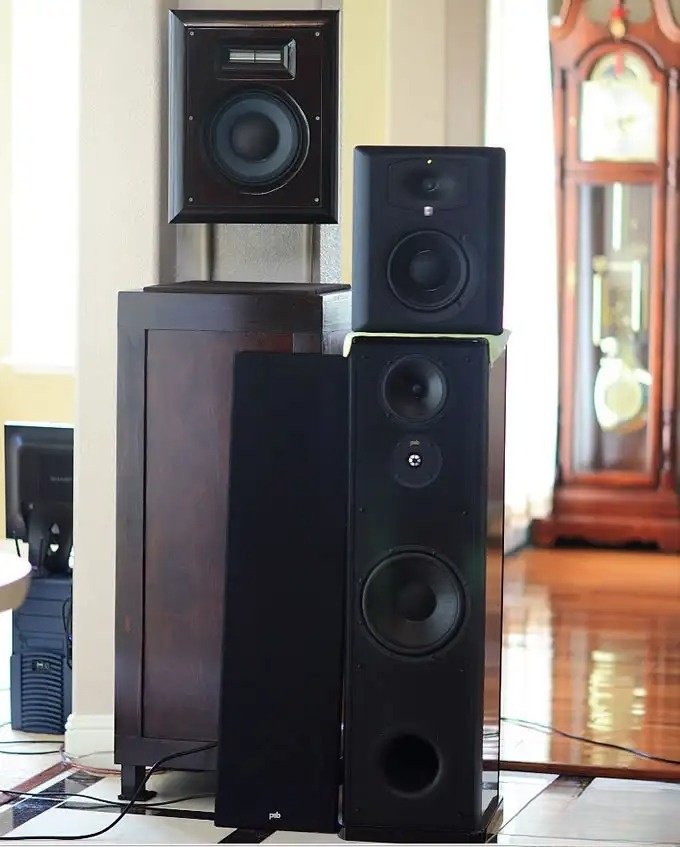
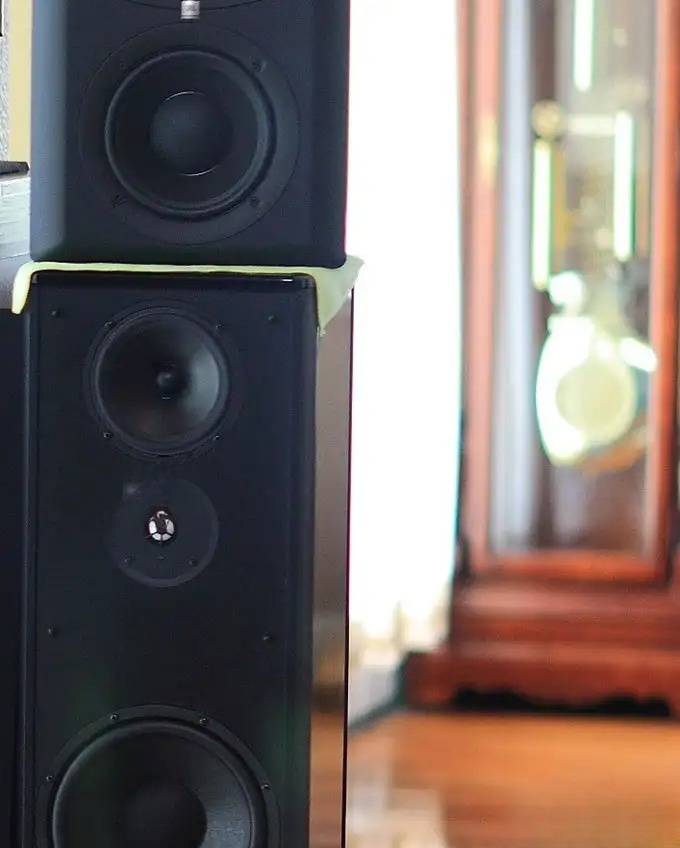
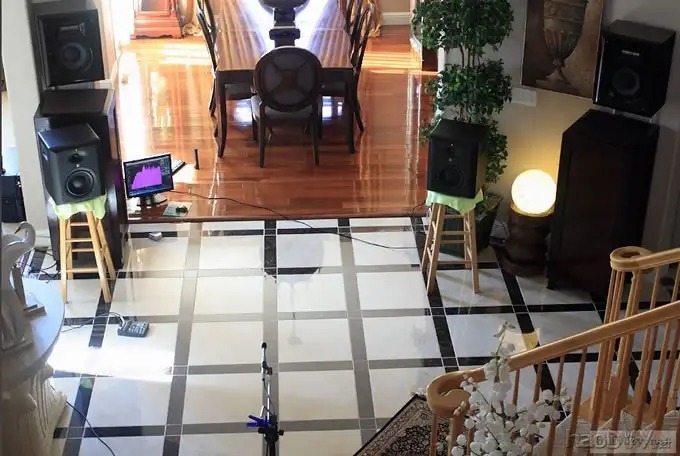
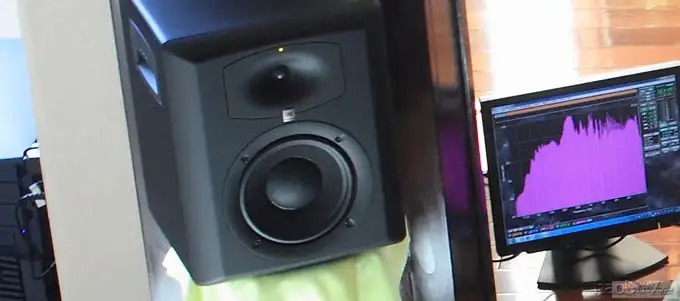
I have mentioned the selection of speakers above, now let's talk about the design of the cabinet.
For the mid-range speaker, I have already introduced the selection of the cabinet volume. I wonder how many people remember where I mentioned it. Because I plan to play with coaxial speakers and sub-bell mid-highs in the future, I adopted the method of replaceable panels, and added a speaker load-bearing accessory to reduce the burden of the panel and reduce the vibration of the speaker to the cabinet. Of course, the cabinet adopts a large chamfer design. In fact, the mid-range speaker is not complicated. There is not much to say.
For the bass box, I pay great attention to the rigidity and shockproof of the cabinet. Therefore, a large number of reinforcing ribs are used in the box. The box board uses high-quality medium-density fiberboard and multi-layer plywood. And I don't glue the two boards together first. Instead, it is a large box inside the box. A little bit of sawdust is used as a spacing between the two boxes, and the inner and outer boards are coated with milky white glue in a grid-like form. I have tested it, and the glue is quite hard after the milky white glue dries. In this way, there is a hard latex glue sticking between the two boards every one centimeter, and the other thin gaps serve to buffer the vibration of the inner board. The two boards inside and outside the corners are staggered and connected, and the decorative panels in the shape of angle irons are placed at the corners, which makes the box rigid. More importantly, I installed the speakers at the top and bottom. According to the principle that the force perpendicular to the point of action is infinite, and only through the deformation of the object can a component force be generated to counteract it, the speaker installed on the side must cause a large deformation of the panel to vibrate and produce noise when it vibrates. Placing it at the top and bottom of the box can greatly reduce the harm in this regard. It is like putting hundreds of pounds on your shoulders, or lifting it vertically with force, you can still stand upright. However, as long as a little force is used to push you behind or in front of your chest, you must move your body to achieve balance. At the same time, with this up and down placement, the passive radiator and the speaker are the farthest apart in the cavity, and the effect is the best. After all, air will still encounter resistance when moving in the box. Placing the two too close will inevitably produce some coincidence. Of course, this up-and-down placement also has some side effects: 1. The bass and mid-high frequencies are not on the same plane. I reduced this side effect by lowering the crossover point and making the DSP delay adjustable. 2. There must be space above and below the box. This is a matter of opinion.
When I was testing the sound in the early stage, when I input pink noise for measurement, I heard the heavy metal sound of the pile driver's hammer hitting the column at the bottom of the box. I thought it was the sound of the loosened large mesons of the radiator. After inspection, of course, this suspicion was rejected. Later, I added film to the box feet and the ground. It was fine. It turned out that this box weighing 180 kilograms would also dance under such a test signal. If the speaker is placed sideways, the jumping will become twisting... Of course, I used latex that is afraid of moisture to stick the small wooden column to the ground next to the box foot, and tightened it with screws to the box foot, so the problem was solved. This experience should be inspiring to everyone.
Another point is that if the speaker is placed sideways, for large-sized speakers, the large magnet (except neodymium) is very heavy. It is supported by the speaker plate frame installed on the side. Its torque is also very large. In static state, the panel supports the magnet through fixed deformation and is in peace. Once the speaker is input with a signal and oscillates, the weight of the magnet will help to increase the vibration of the box. At this time, I remembered the state of the passive radiator or the reversing tube suppressing the resonance of the speaker, which can be described as self-inflicted. Haha, self-inflicted, helping the evil, helping the evil, self-inflicted... Friends, how much do you understand? The solution to this problem should be like the load-bearing accessories of my mid-range speaker. You can reasonably transfer the weight of the large magnet stone to the box by installing it on the reinforcing ribs. Because my speaker magnet has long been protected by rubber, you should pay attention to the shockproof of the magnet.
There is one more thing to mention, the diagonal baffle in the box! Many audiophiles use layers to stick together to form an arc-shaped box. Large manufacturers use heavy presses to press and add arc-shaped boxes. What a huge cost, the main purpose is also for this
Speaking of listening experience, this is something I am very reluctant to talk about. This is something with a very personal color. It is easy to mislead. I was also deceived and took many detours at the beginning.
Now I will also share why I use aluminum ribbon tweeters: 1. Many documents or materials agree that it can easily output frequencies up to 40KHz or even higher. 2. The sound body area is large compared to the spherical shape, and the advantage is that, 3. I have been paying attention to the blog of a self-founded company that makes speakers. At the beginning, he blew up the recognized brand tweeters as a god. But it uses the aluminum ribbon unit of more than 90 US dollars from Fentek in its own products. Now this person is developing the most high-end speakers, and he also uses a foreign aluminum ribbon of more than 700 US dollars. And in his blog, it is also known that this tweeter is still handmade. Even the panel lacks screw holes. I noticed that the performance of this top-end aluminum ribbon of Fentek is not inferior to it, but the price is only half. This is easy to understand, the salary of foreigners is dozens of times higher than that of Chinese people. This tweeter is not high-tech. It is just some important craftsmanship in hand-made production. At the same time, the domestic Jinlang aluminum ribbon of the same grade also costs 550 US dollars. At that time, I referred to some famous speakers and monitors, all of which used aluminum ribbon. So I chose this tweeter. In addition, the price difference of aluminum ribbon tweeters is very large. And there are two types, please pay attention.
Now, in my audio system, I have always used this tweeter. The JBL titanium tweeter and psb tweeter compared with it are not in the same system. It is inevitable that the listening judgment is a little inaccurate. The sound of the aluminum ribbon tweeter is obviously delicate, clear and not ear-catching, a little sweet, and no burr feeling (maybe system problem). The dome tweeter is bright and ear-catching, a little uncomfortable, maybe it is called hard. I looked at the spectrum, the high frequency is pulled up at close distance, and the high frequency drops faster at far distance. When the aluminum ribbon is placed vertically, the directional angle is obviously about twice that of the dome. I believe this titanium tweeter should be a high-end product of JBL. Because my pair of active monitors is the highest level of the factory, the dome tweeter is also coated with a layer of black film on the metal. Maybe it is better to describe them as hard and soft. No wonder some professionals don't like them. After all, hard ones are better outdoors.
This aluminum ribbon tweeter is the most comfortable to use. Its spectrum is very flat at near and far points. It is the most worry-free when matched with other speakers. You can see it by reading my previous posts.
Once again, don't trust the listening experience too much
Calculation of the volume of the bass box: Because the low frequency needs to be 20Hz (-3db). This will be the minimum output of the speaker. So the radiator should have the maximum output outside. Moreover, according to the data, the output of the radiator will attenuate by 18db beyond the peak value. Considering that this kind of output will increase the group delay distortion, the lower the frequency, the greater the delay. However, at this time, people's hearing sense of the extremely low frequency is also weaker. On the surface, this is a very contradictory problem: when the output frequency of the passive radiator is closer to 20Hz from high to low, the measured delay is greater. And the bass above 30Hz is more output by the speaker. In addition, I can use EQ to straighten the output of the radiator and the speaker, and there is no need to make the output of the bass speaker impedance equal to the double peak like an ordinary box. And the Fs of the speaker is also around 20Hz. According to the radiator tuning-weighting-box relationship table provided by the manufacturer (previously posted). In addition, I can accept the box volume. And considering that the amplitude end of the output is still in a small flat range, it is decided to select the resonant output around 21Hz. From the impedance diagram (previously posted), it can be seen that it is actually about 22Hz. The net volume of the box is about 100 liters. Because of the addition of a lot of reinforcement ribs and two layers of boards and decorative panels, the external volume is of course much larger.
In this way, the low frequency heard is more directly output from the speaker, but the measured delay distortion is greater. Haha.
In addition, lspCAD software can also make box calculations. There is also an option for this DSP:
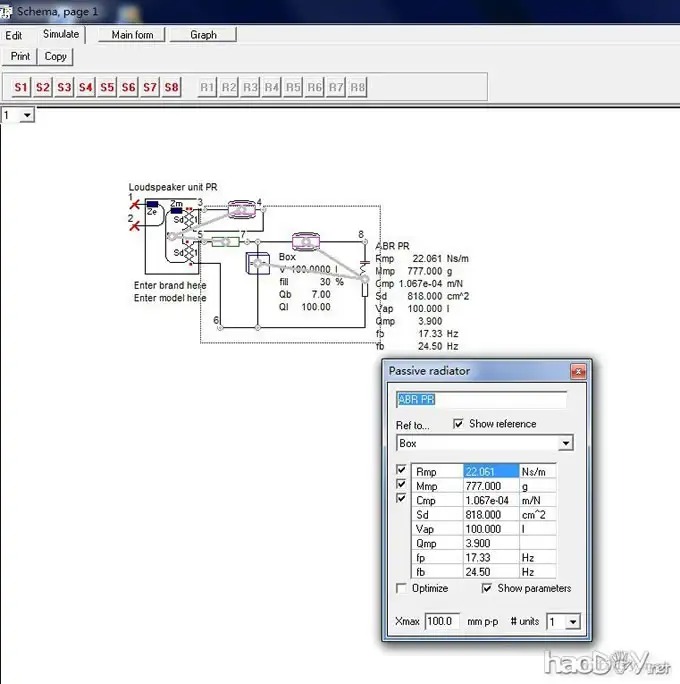
The introduction of this set of speakers is basically over. Based on the spirit of sharing, it shows that beginners can also make such high-end boxes; mainly because it uses DSP, which is rarely used by everyone. The cost is not high, the technology is not low, and it has been on the market for a long time. Moreover, the measurement indicators of this set of boxes are all amateur means. As I pointed out in my previous post: professional speaker manufacturers also indicate in the measurement parameters of their own products: the data below 200Hz is inaccurate. If you pay more attention, the frequency response of 20Hz-20K is marked on the indicators of the extremely high-end boxes of some very famous manufacturers. My post shows that we amateurs have the ability to impact it. I hope everyone will understand. It does not mean that I am not rigorous in sharing, nor do I want to promote high-end, nor do I want most of the high-end boxes to be made.
Dly boxes should not be imitated. What I share is just a special experience. So, 1. Replace the passive radiator with a bass reflex tube. Even better, a baffle can be used to form a square inverted tube with the three sides of the box. This baffle can be pulled out and inserted to adjust the tube length. It is best to insert this baffle at a certain angle to make the inverted tube horn-shaped to reduce the noise generated by sound waves. 2 High, medium and low-frequency speakers can be placed on the same front, which is no different from traditional speakers. However, the magnet load-bearing method and the diagonal baffle method should be used as much as possible. Regardless of whether the box is sealed or open, the diagonal baffle can be used. It does not need to block 100%, and it should not be made into two completely separated triangular cavities physically. It can be made into multiple baffles and placed in a staggered manner. In terms of the reflective surface, it plays a separating role. In terms of three-dimensionality, the cavity in the box is still intact. 3. The use of DSP breaks many traditional methods in Dly boxes. However, the box and the speaker should be regarded as a whole, a life. In this regard, the traditional method is applicable. Try to use the software design and testing advocated in the forum. Once the box is made, it is more convenient to use real-time frequency response software for frequency division, debugging, and environmental adaptation. 4. You don't need to read too many books on making boxes, but you must master the basics, especially several important parameters of the speaker. Then browse the parameters of a large number of various speaker units on the market and the Internet. Master the differences and mysteries among them. Never use the method of listening to find speakers, because the speakers produced by the manufacturer are not tested by listening to whether they are qualified. In this way, you can design different boxes with ease, just like holding thousands of troops in your hands.
Experience: Bass - force, high and low frequencies - phase. This does not represent everything, but it is the key point.
I believe that friends have tried to use a test disc with continuous output of different frequency signals to measure the system. However, this different frequency output cannot stay for any time, and the signal width is too large, not a certain frequency point, but a frequency band. The software I found online, if you select other functions during use, is no different from the disc function mentioned above, but click on the #p#page title#e#no sweep function, you can enter any frequency point, and the Q value is extremely large, that is, the output center is at the frequency point, and the peak shape is very sharp. This is very convenient for testing.
What test to do? You can check whether the output size of the system is consistent at different frequencies. The most inhumane method (the biggest difference between humans and animals is that they know how to use tools) is to judge with your ears. I often see people asking questions on the Internet about how to match subwoofers. This method is the simplest; whether the high, medium and low frequencies are balanced can also be used in some ways, which is better than listening to music with fluctuating output and unknown frequency points. However, it is particularly important to note that the human ear is not as sensitive to bass and treble as to midrange. When you use your sense of hearing to balance the full range. A and C weighting corrections have been used. That is, when measured with a sound pressure meter, the high and low frequency bands are enhanced. Professional music producers record music files in the monitoring room using a monitor or headphone monitor with full-range flat output without any correction. He naturally tries to produce the most beautiful music with professional standards and human hearing. Playing this music on a monitor that you have adjusted to a flat level with your hearing is equivalent to making two corrections.
A further method: Now everyone has smart phones, pads and other things, see if you can download audio measurement software and use it as a sound pressure meter, as shown below;
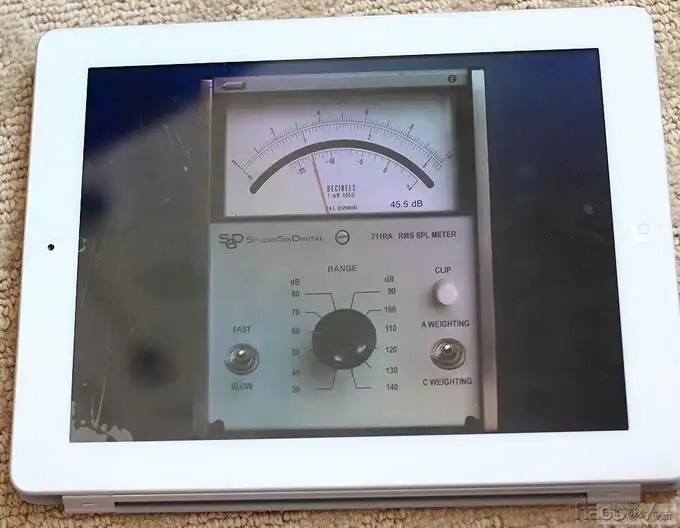
The above two methods are not very reliable. I used this software to adjust the output to 15Hz, and it can make obvious sound in the small box. But in the system mentioned in my post, I only see the speaker, the empty paper plate moves desperately, but I can't hear anything. Why? The small speaker also reciprocates back and forth under the drive of electric current, but can it output the correct 15Hz infrasound wave? The output is just the noise generated by mechanical movement. In this case, using the spectrum to monitor becomes much more interesting, and it can be used as one of the methods to test whether the box is well made. (follow-up)
First attach the software, unzip it and double-click the executable file to run it, no need to install
Download addressa/ruanjianxiazai/shejiruanjian/2012/1005/2020.html
Download the above software and unzip it. Double-click the audio signal generator.exe, and the following window will appear;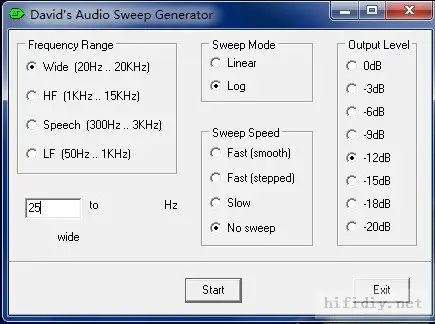
and press its settings. Enter the frequency number and click star. You will hear the corresponding signal noise. The waveform of its electrical signal is as follows;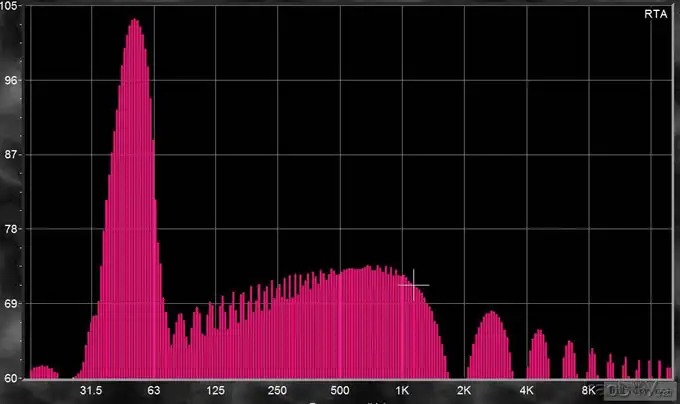
zoom in,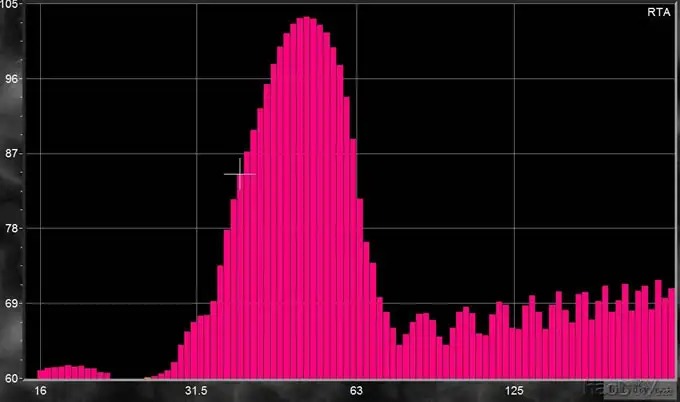
from the above figure, this signal has an amplitude of nearly 40db, which is very good for amateur measurements.
In this way, everyone has an intuitive understanding of how the signal output by this software is. Let's use graphics to analyze the response of the speaker to the electrical signal:
1. Indoor noise, the average value is about 45db. The figure below is the noise curve in the entire audio range.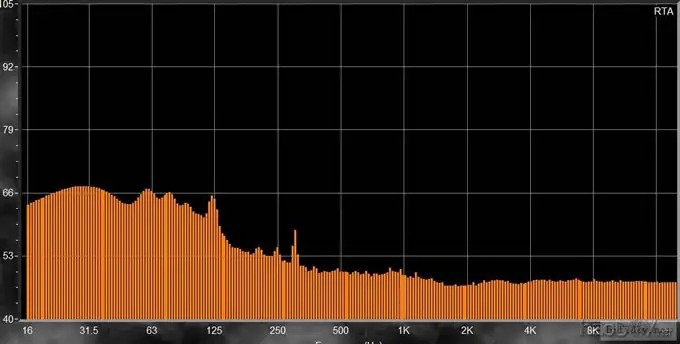
In fact, this is a very quiet environment. The bass may come from the sound of the refrigerator compressor, and there is also the sound coming from the room. With this kind of sound pressure, the ears can hardly hear anything.
2. The sound of an airplane passing by in the distance (fun).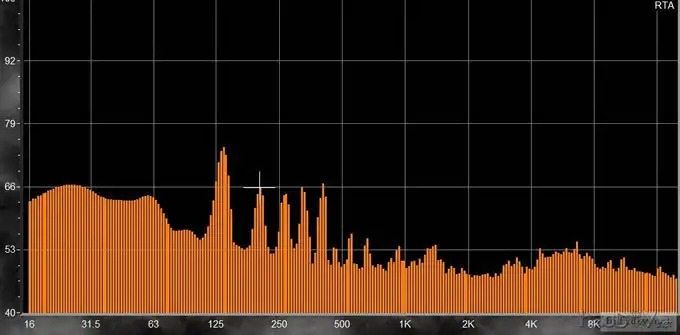
The following are several frequency response graphs. Blue is the electrical signal, and green is the response of the sound.
20Hz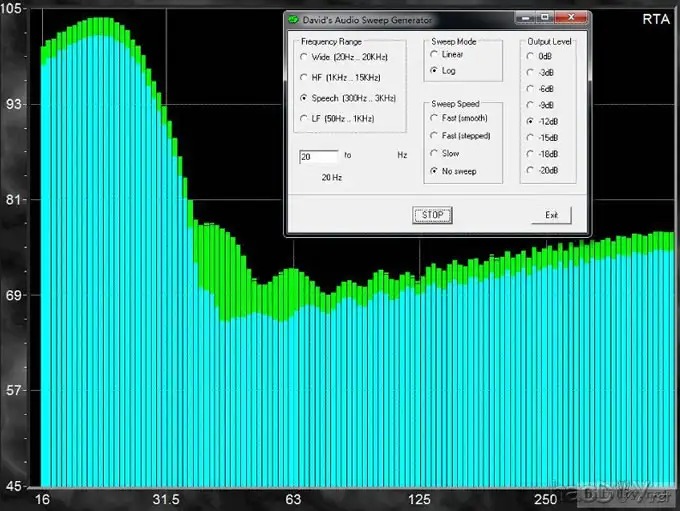
22Hz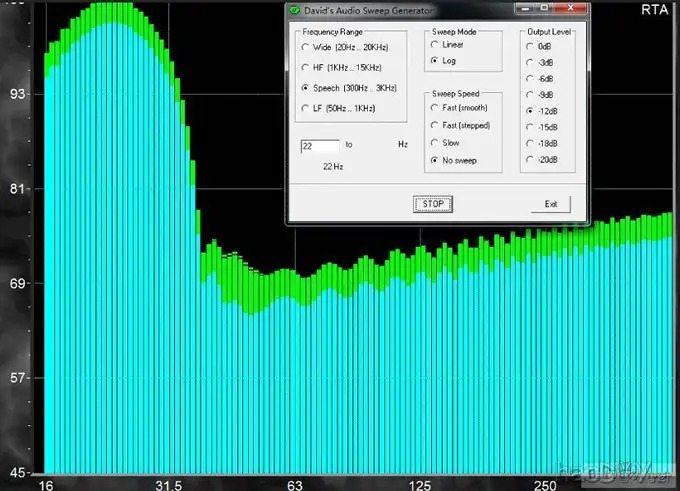
24Hz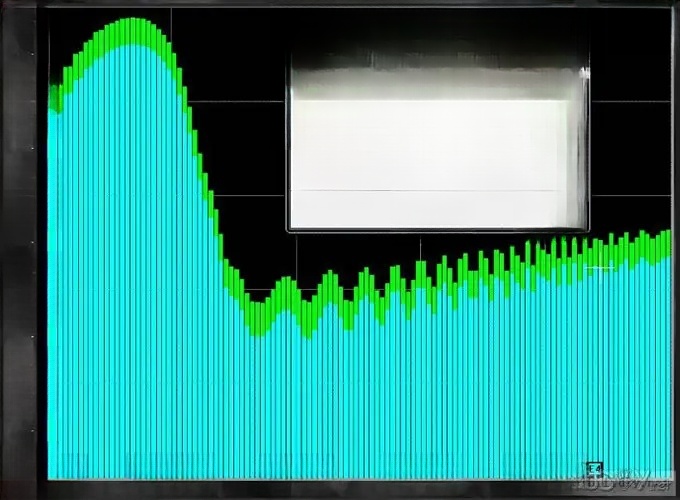
30Hz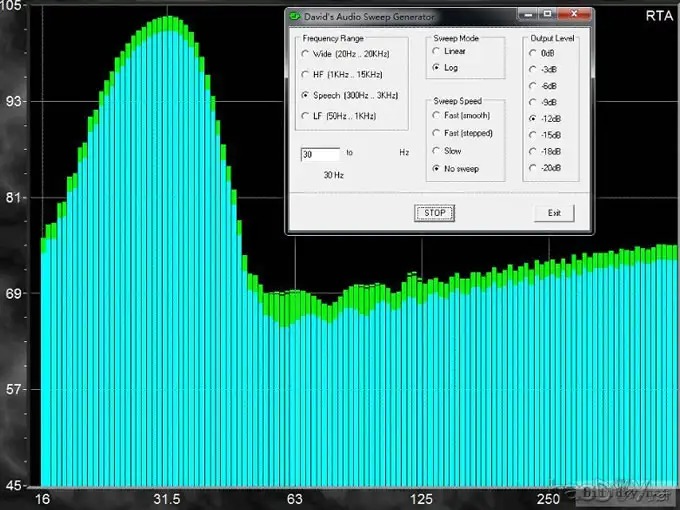
36Hz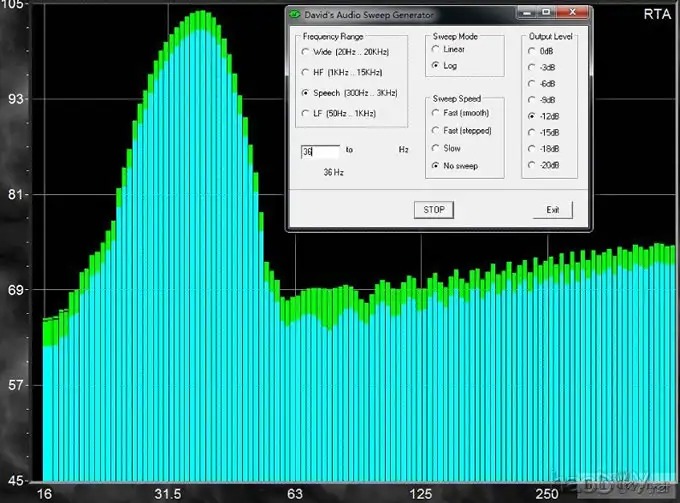
50Hz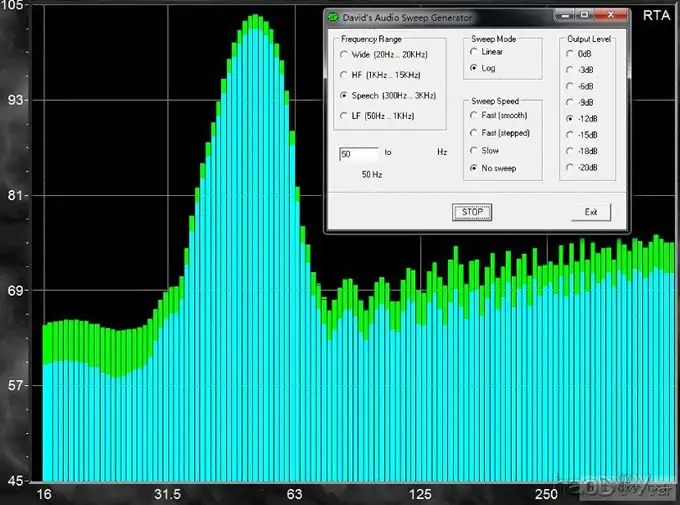
50Hz Zoom out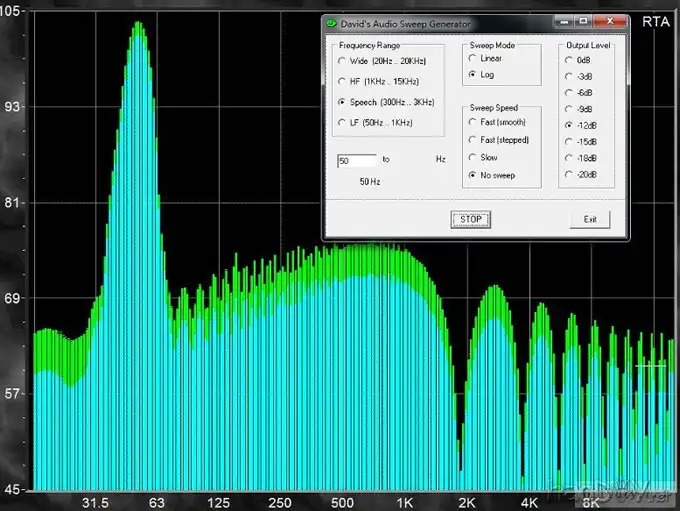
Let's analyze the response of 20Hz in particular. The following figure is consistent with the 20Hz figure above, except that the color of the recording is changed. The red is the electrical signal and the blue is the response.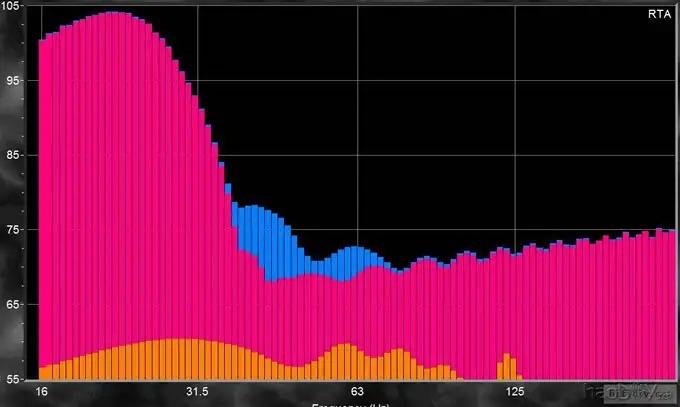
Obviously, blue appears between 40Hz and 70Hz, and red and blue are completely equal in other places. This is distortion, perhaps from something oscillating in the listening environment. Only the distortion amplitude at 40Hz is 78db, which is 26db lower than the maximum response amplitude of 104db, which is exactly one-third of the total, and it is completely indistinguishable in hearing. After that, the frequency response of other frequency points overlaps with the signal. But in the frequency response diagram of 80Hz, burrs appear at 250Hz, as shown in the following figure.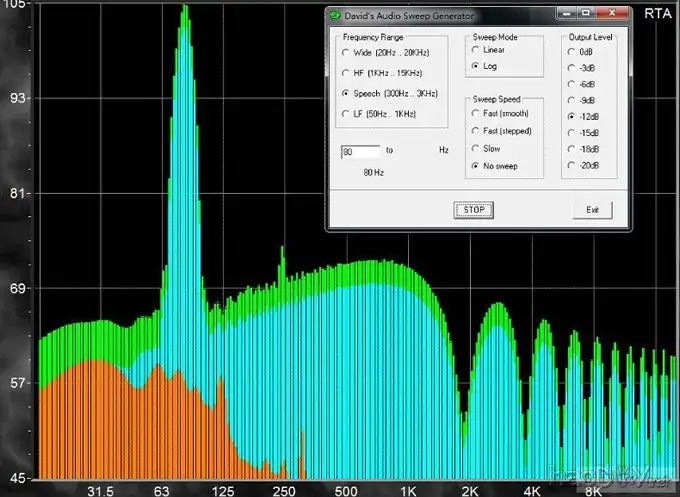
Because the amplitude is very small, the human ear cannot distinguish it. This analysis is not very rigorous, but it is quite valuable for amateurs. If you use this method to test the 20Hz input I mentioned earlier, but hear a clear sound, the graph clearly shows that there is a huge difference between the electrical signal and the response.
In addition, when the output is 20Hz, you only feel your heartbeat accelerate, and your ears feel air pressure, but the hearing is very small. In
the above test, the microphone is placed at the listening position.
If you are interested, you can test and compare to see if the low-frequency response is better than this. If some friends do not have test tools, but look at these intuitive graphs, use ears to listen, and measure with a sound pressure meter, they should have more feelings.
Reiterate: The above method is not rigorous, but it is very good for comparison and reference for amateur use. When the frequency points are not far apart, you can just use a chat microphone. This method can also draw a frequency response curve based on the difference between the electrical signal and the response.